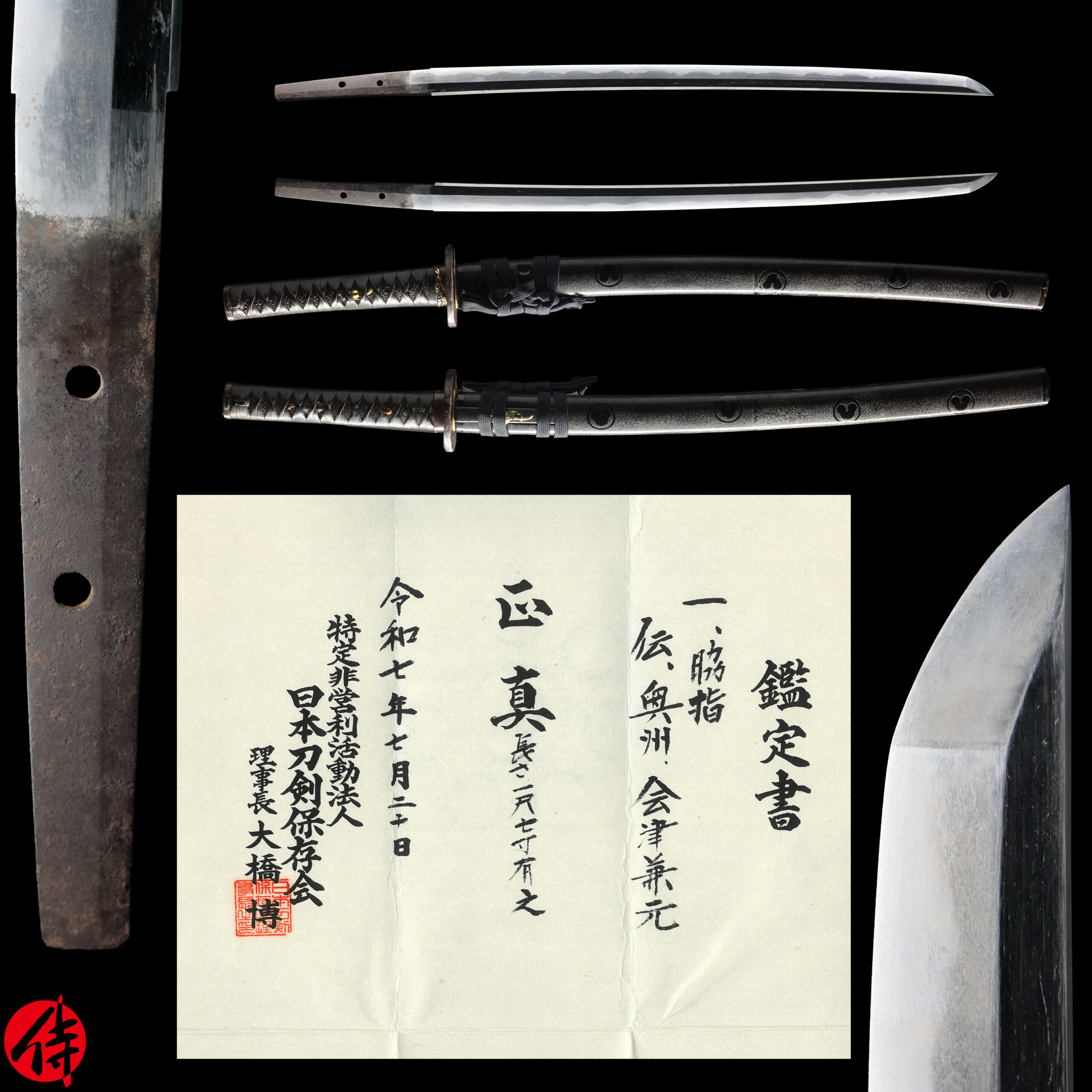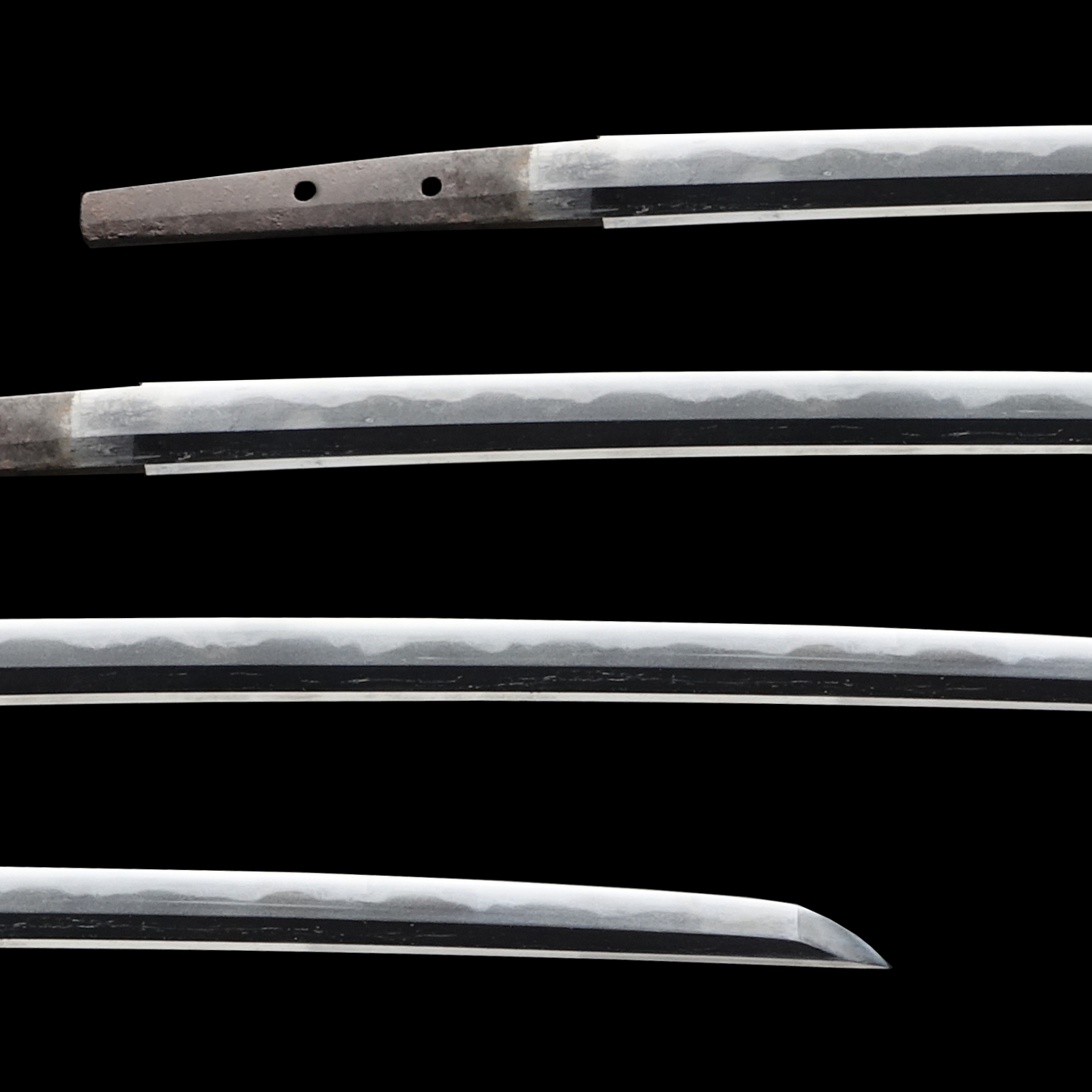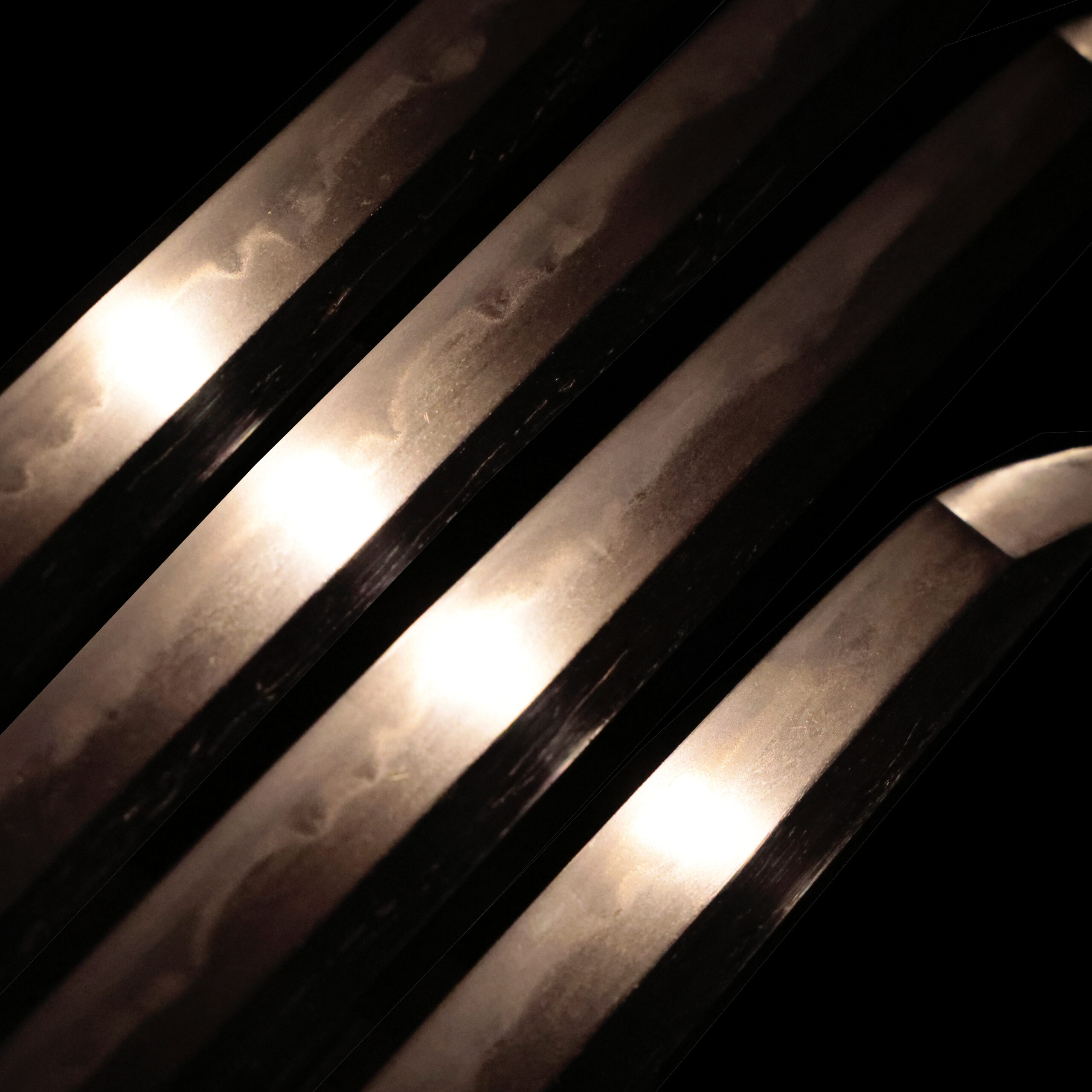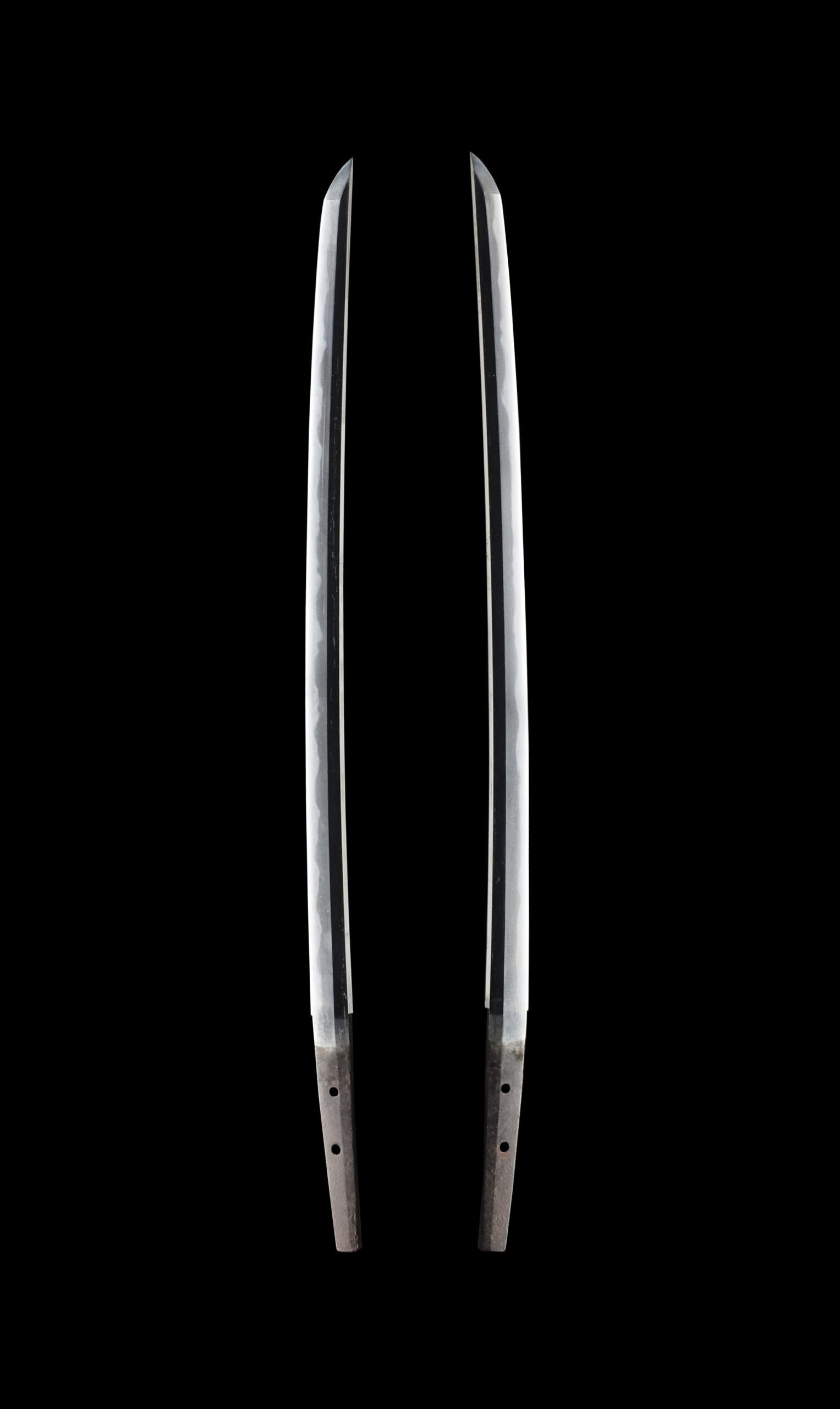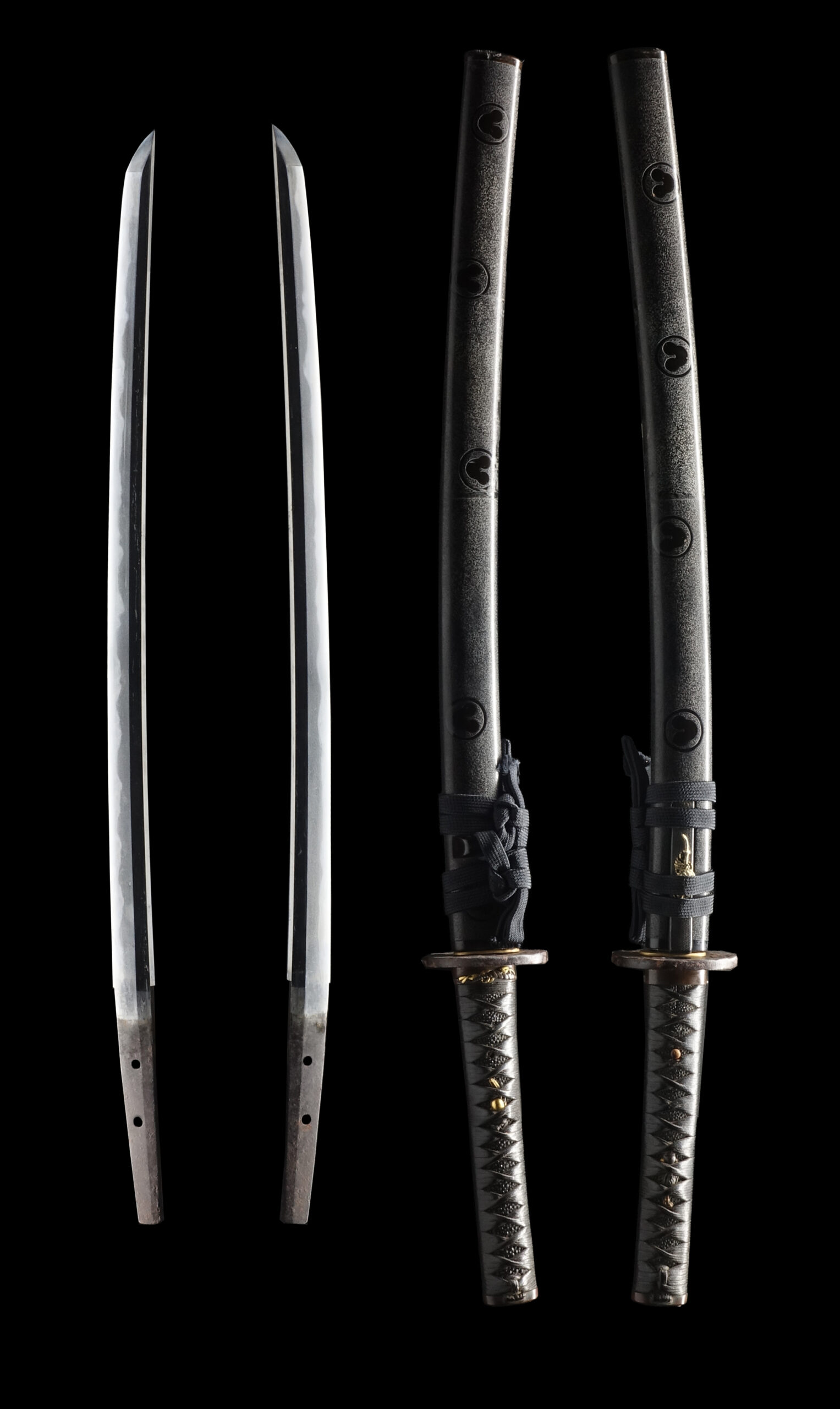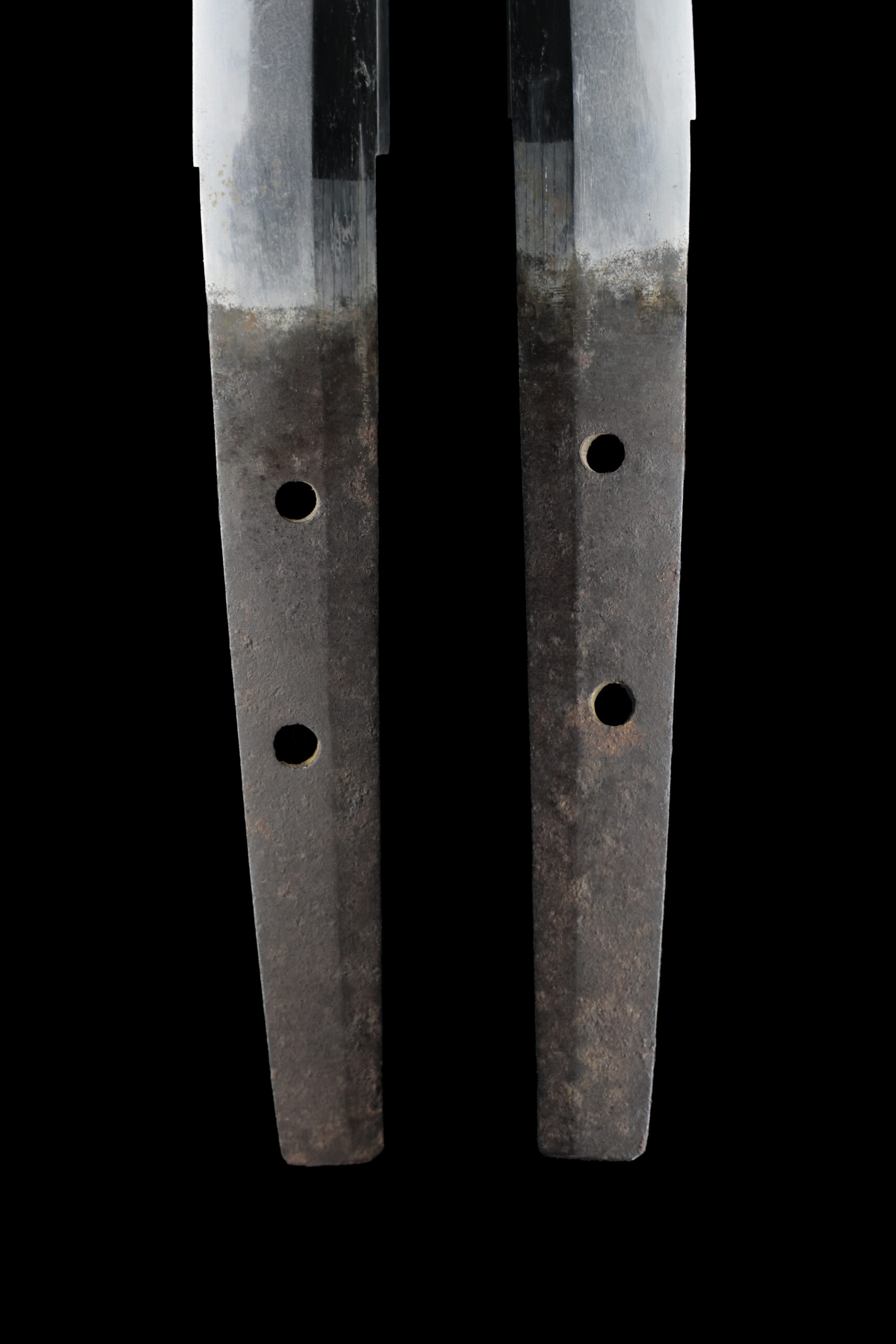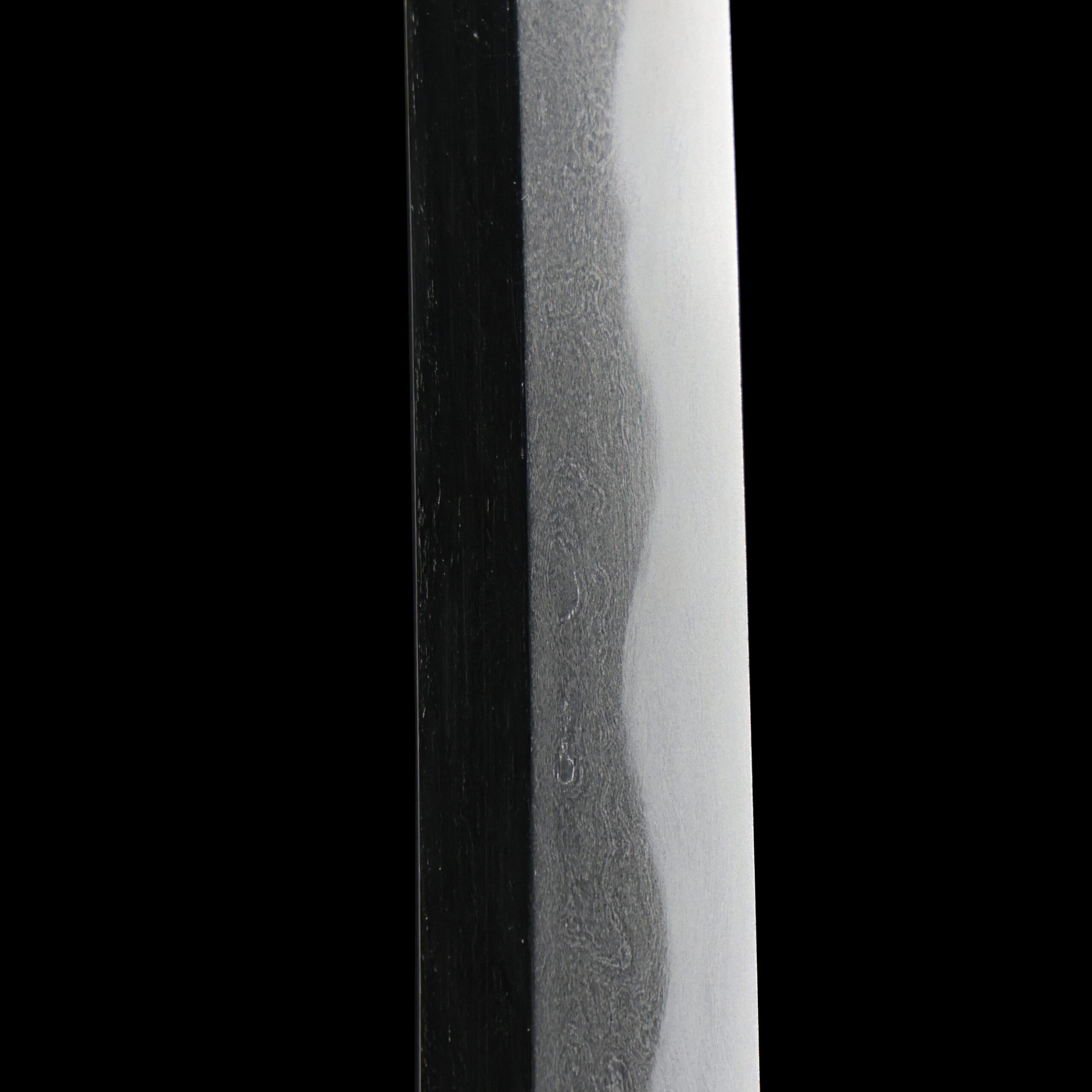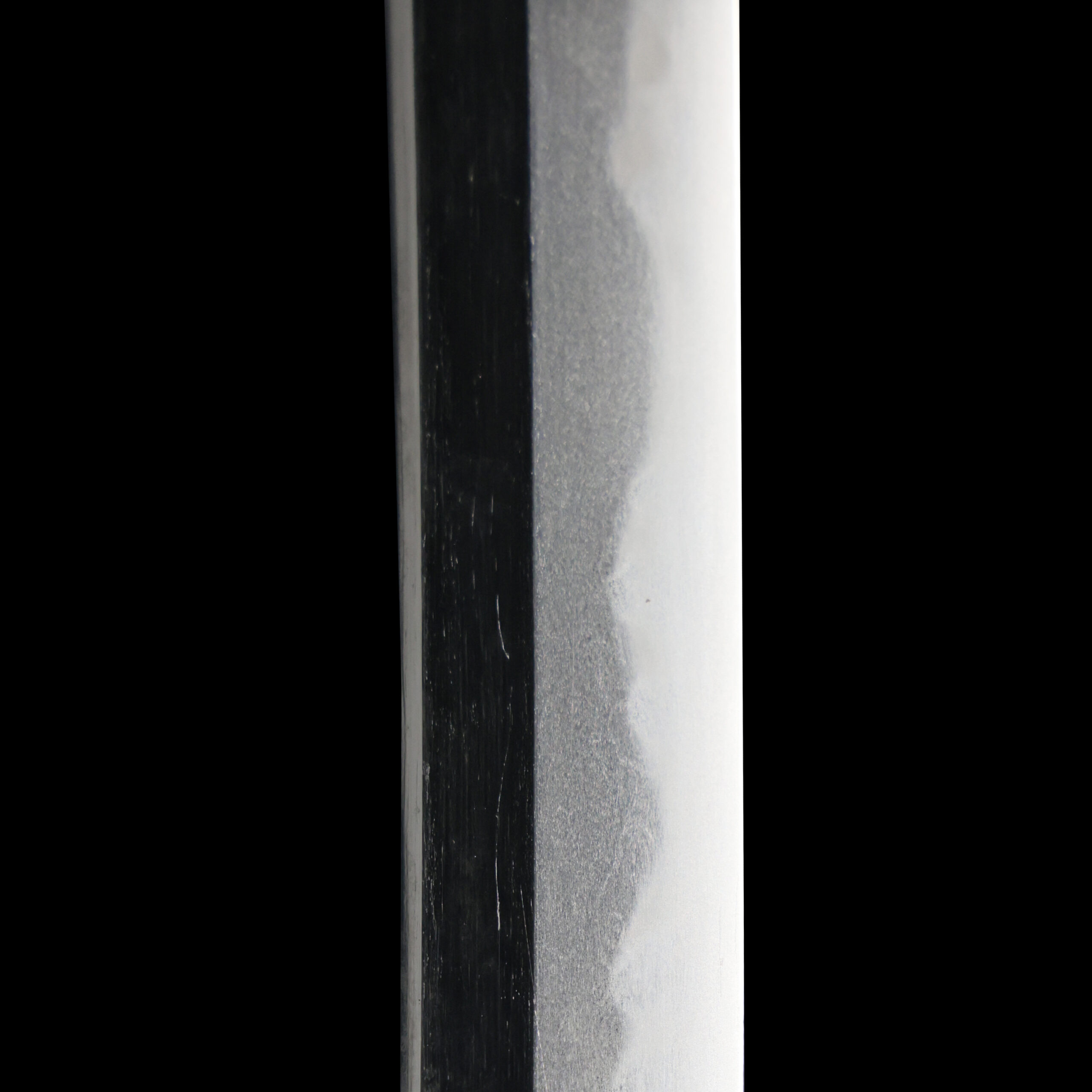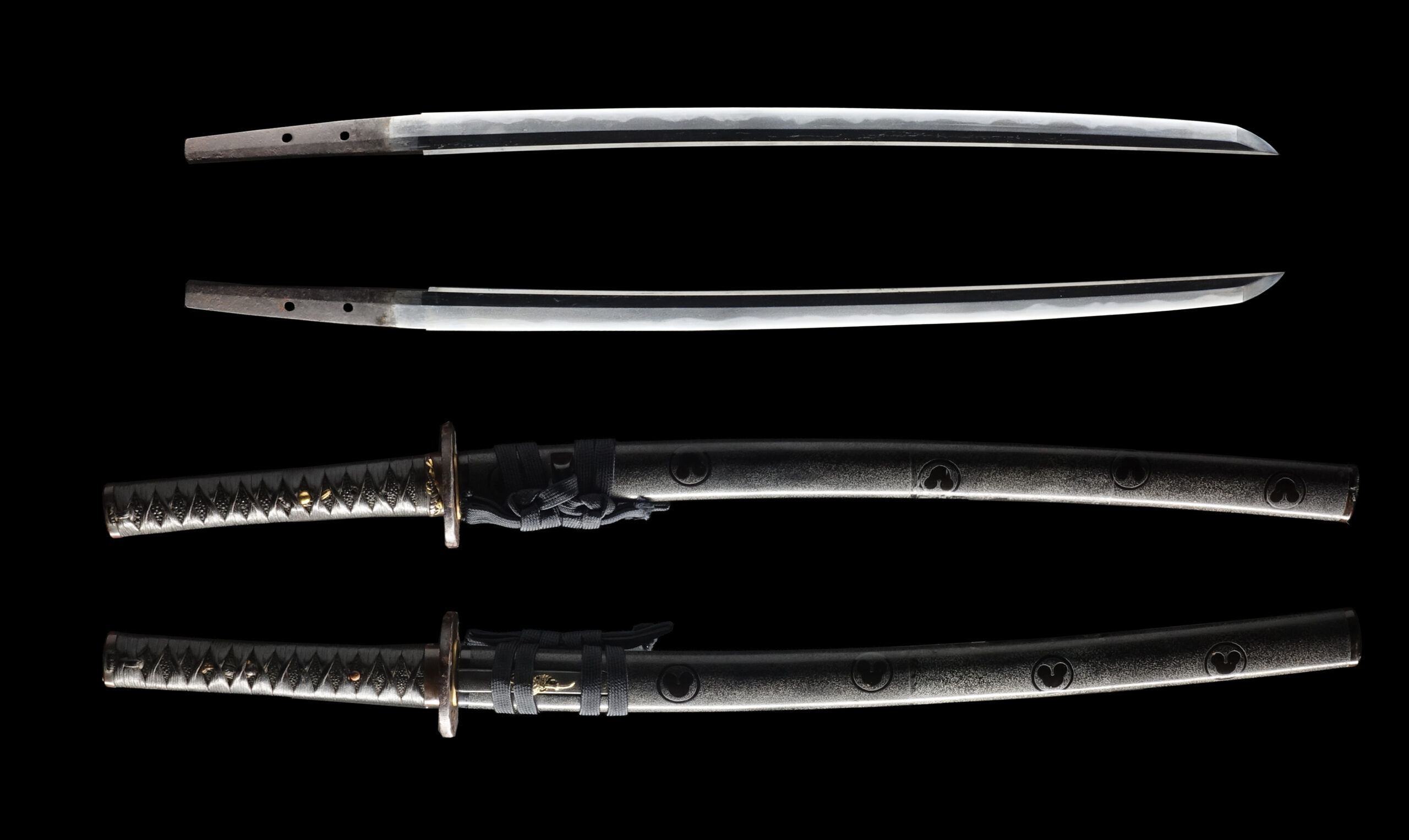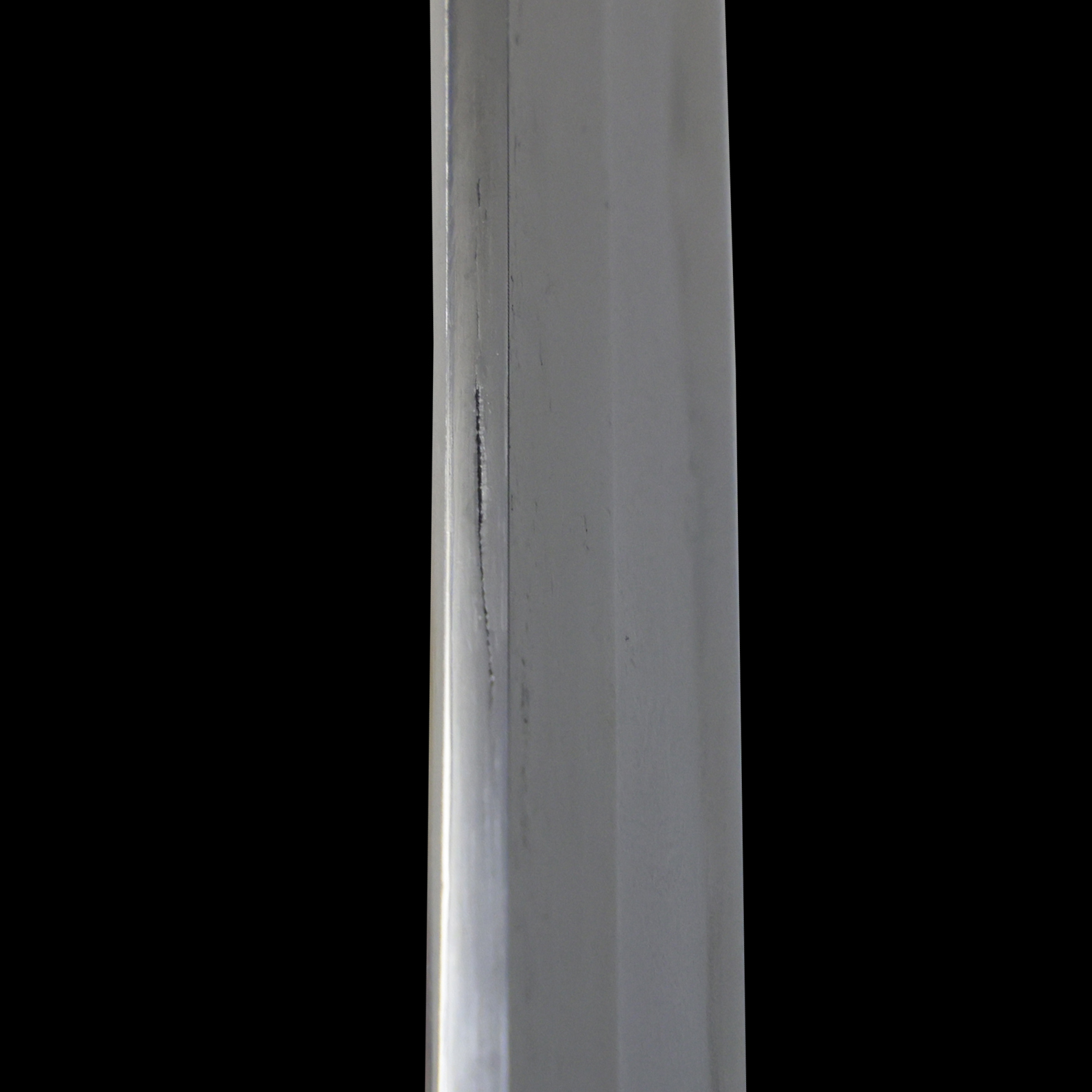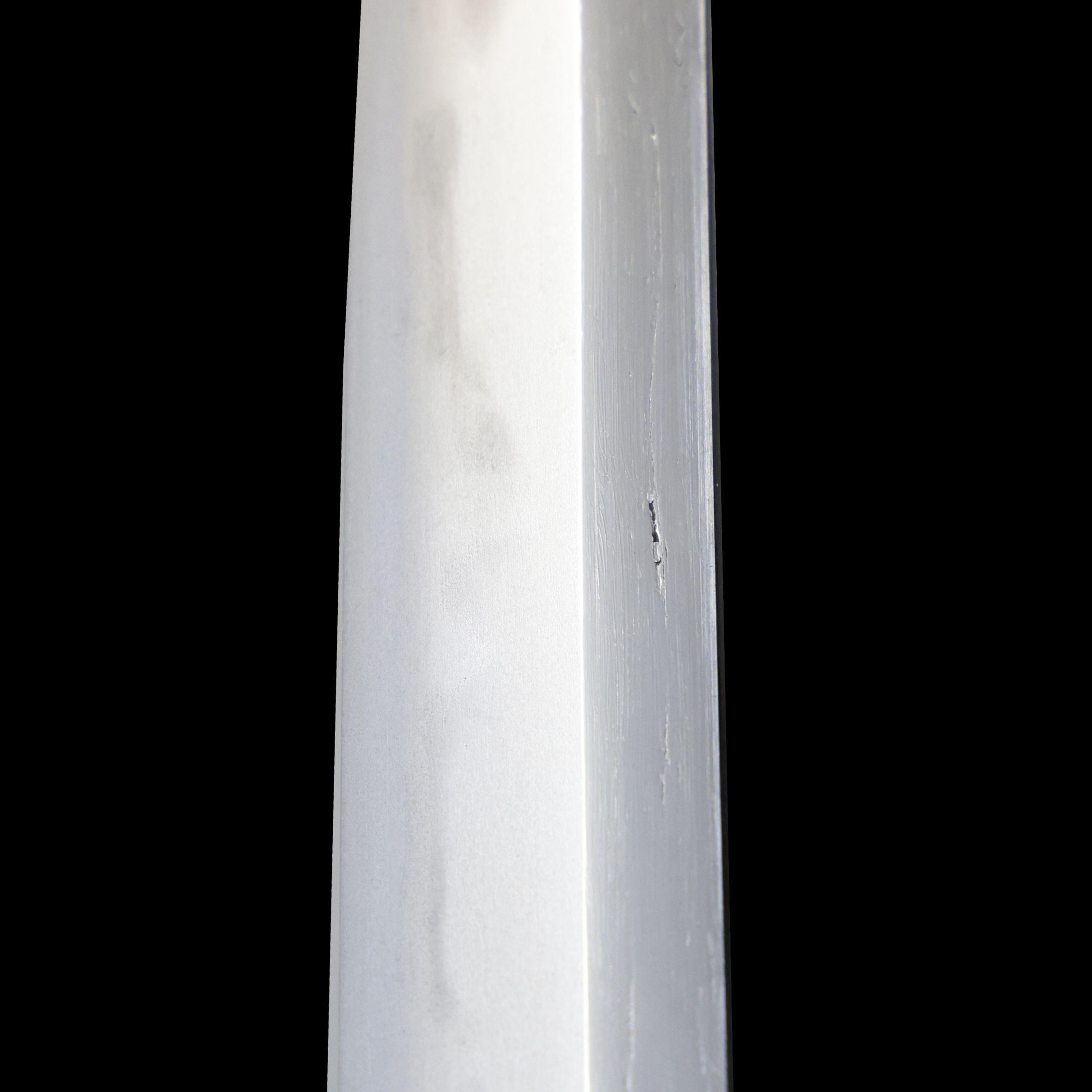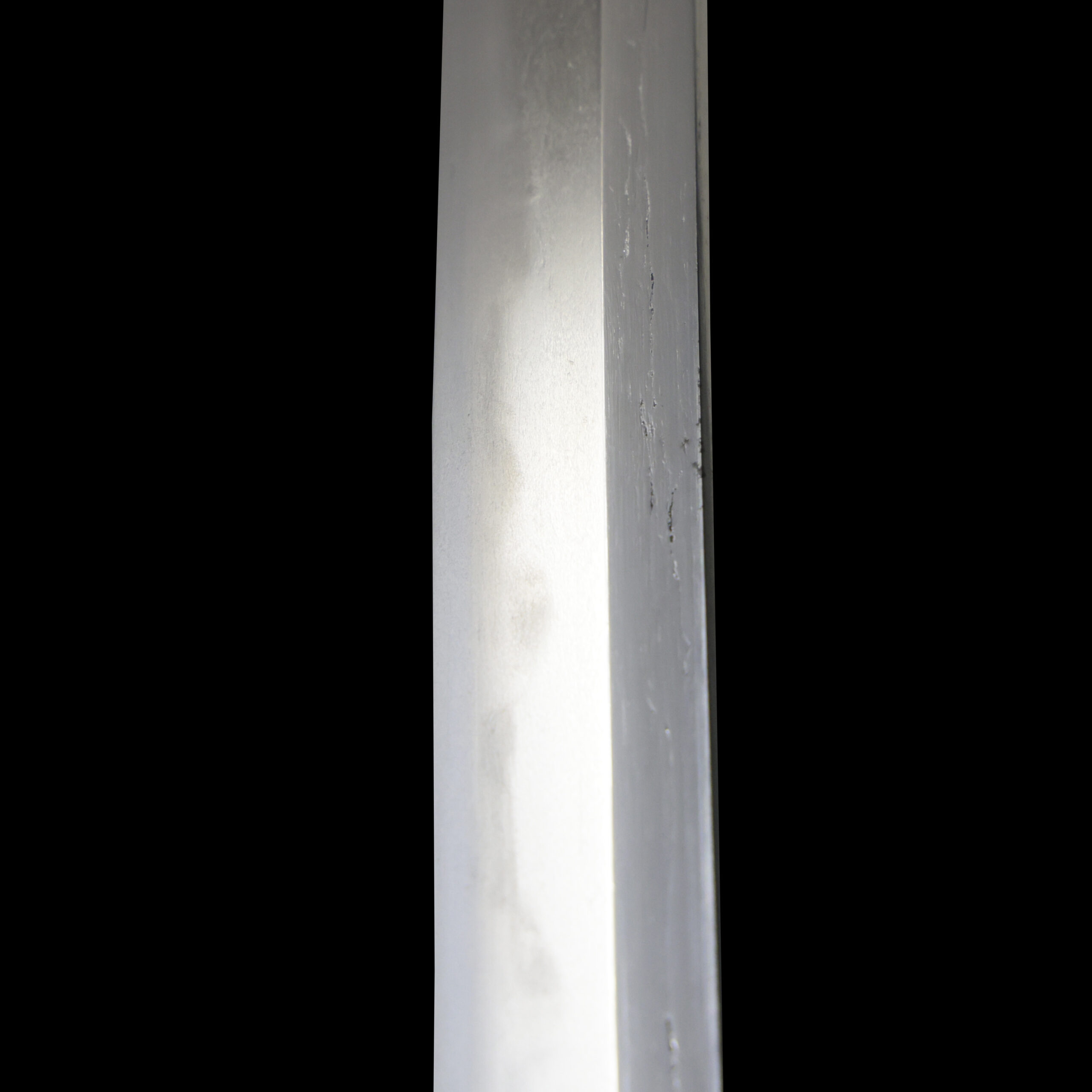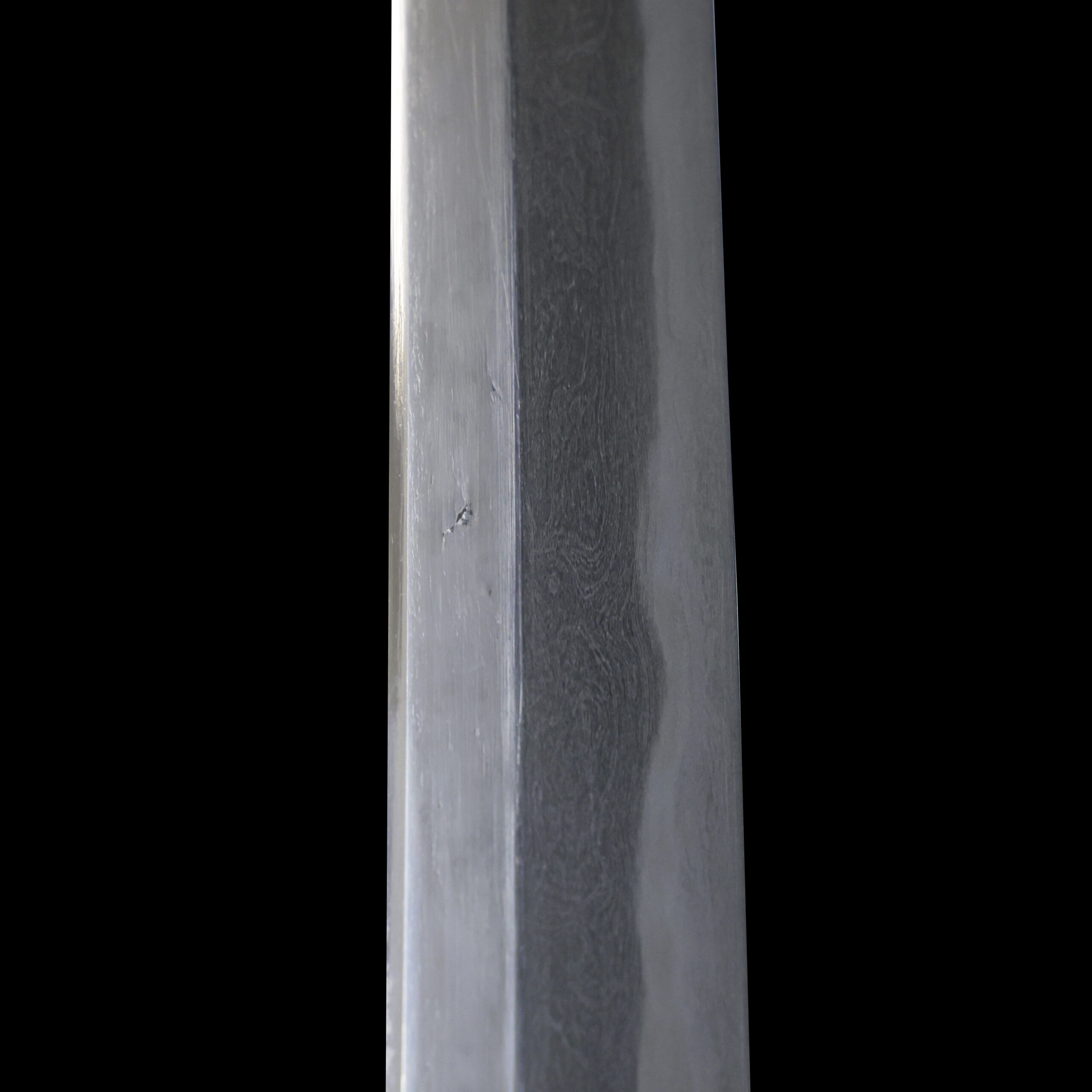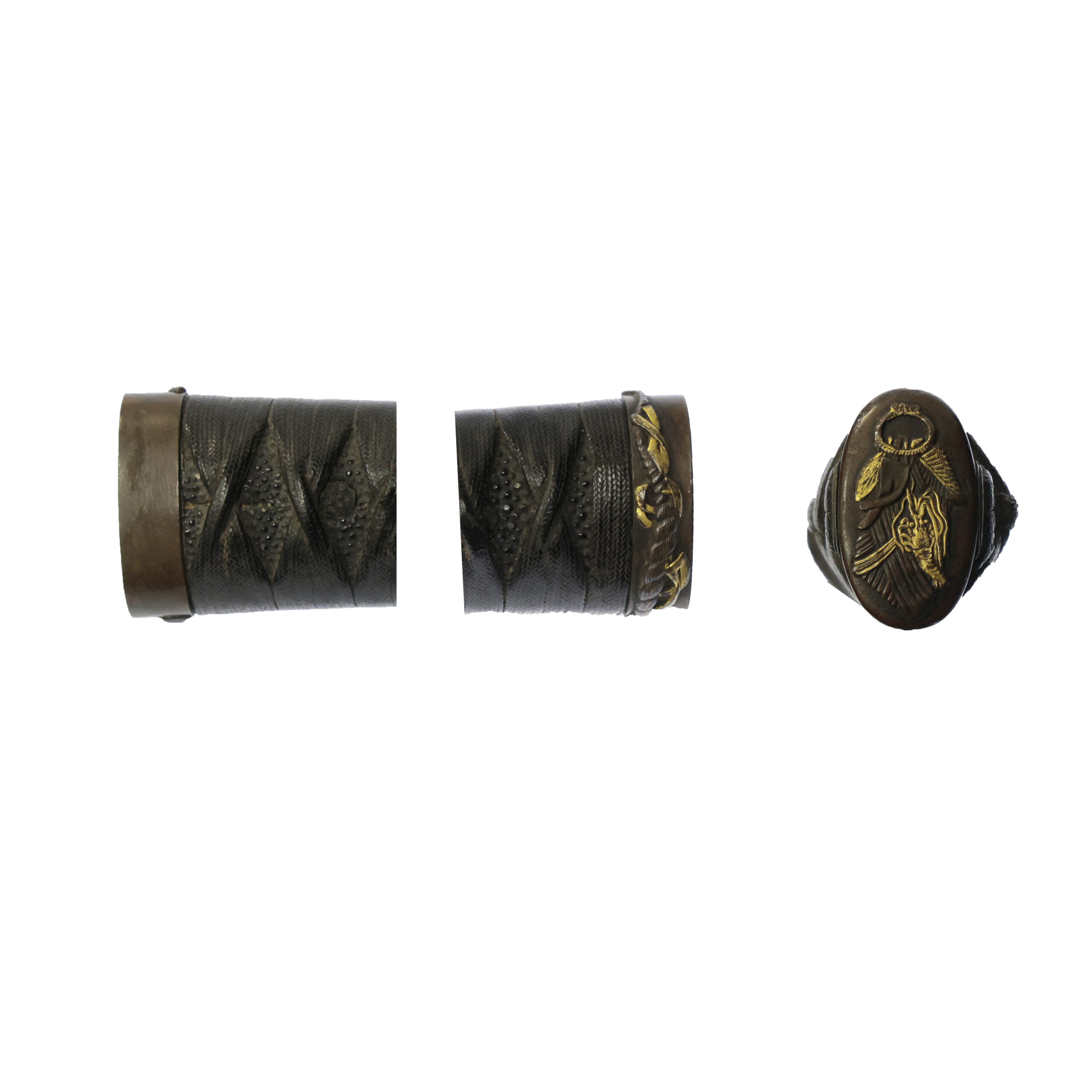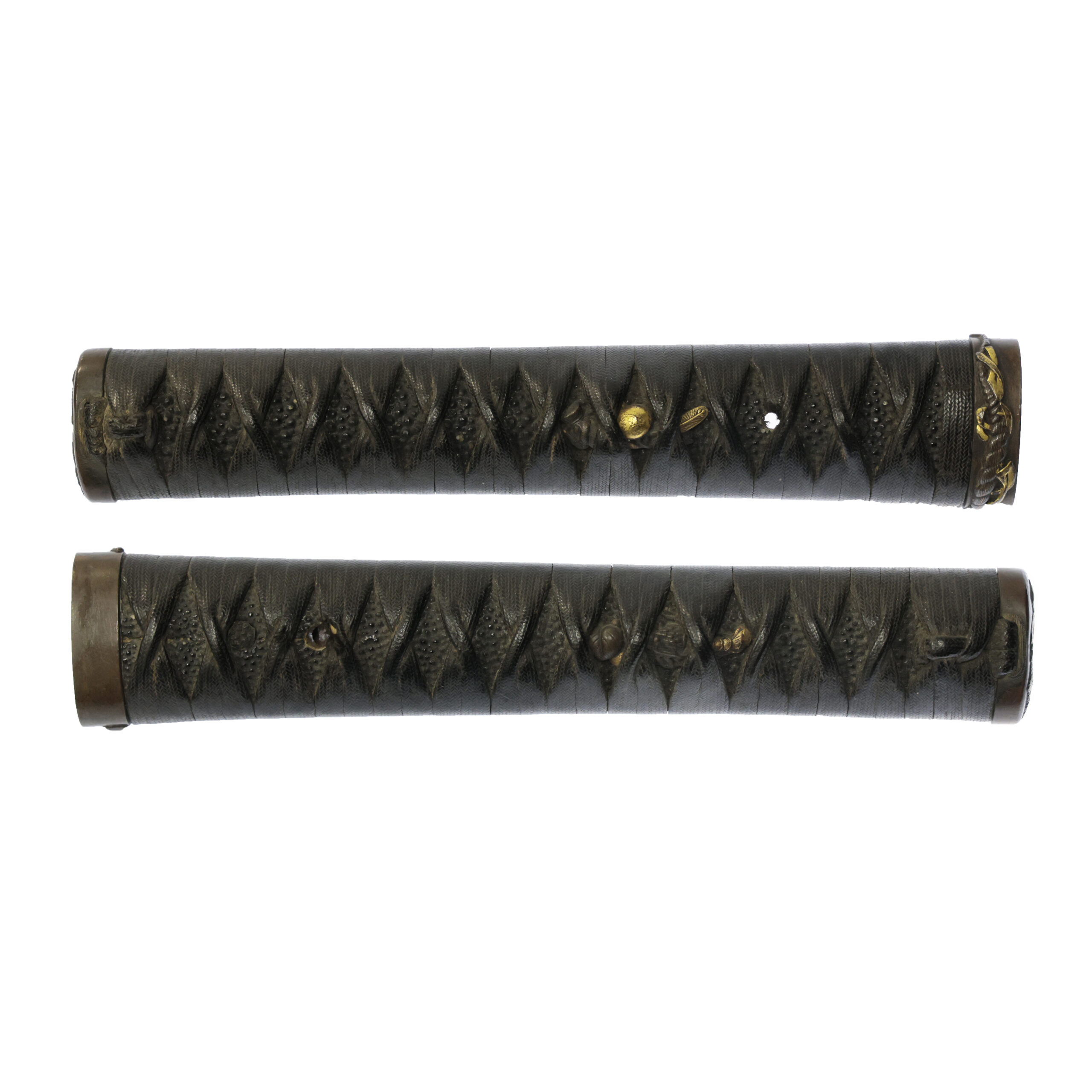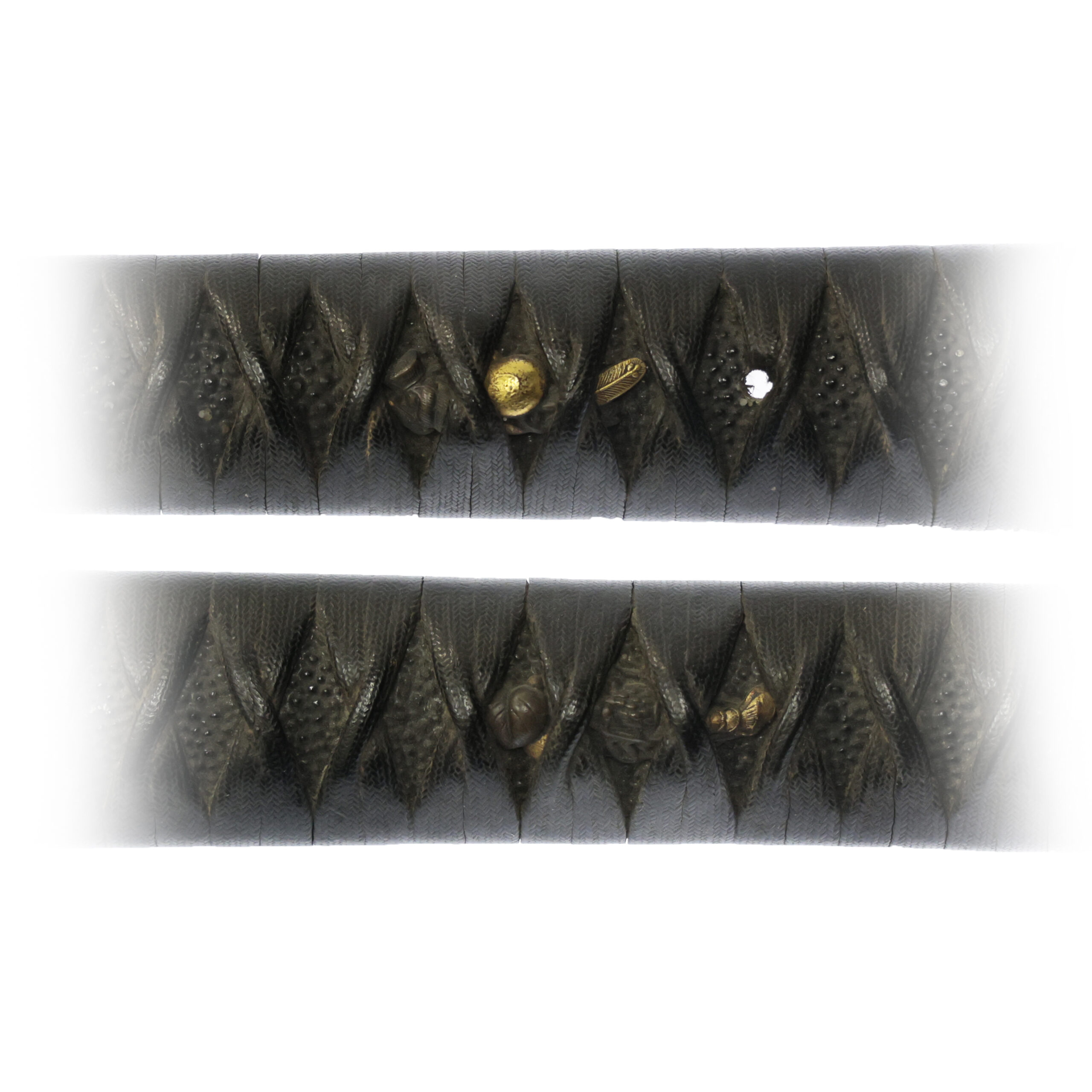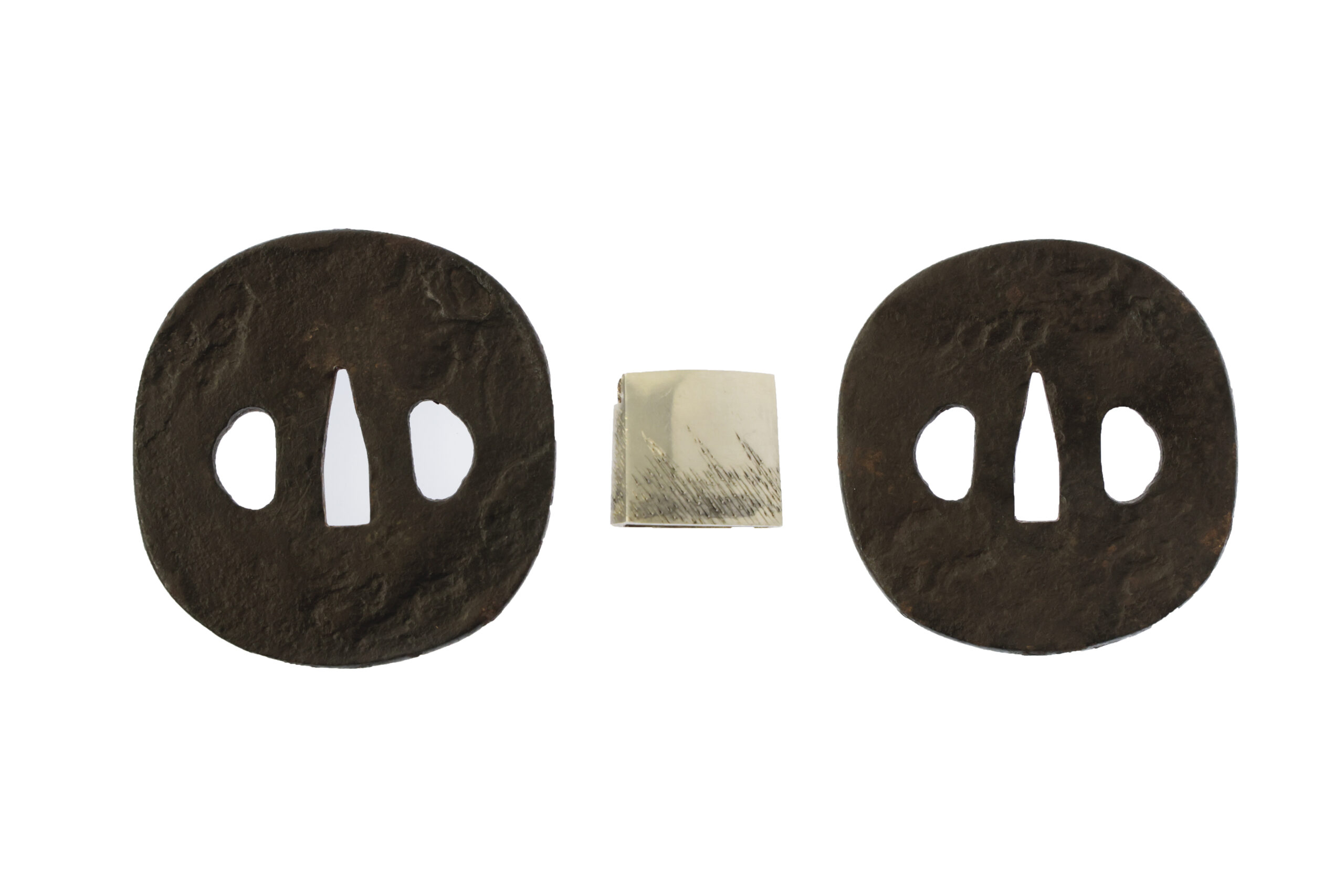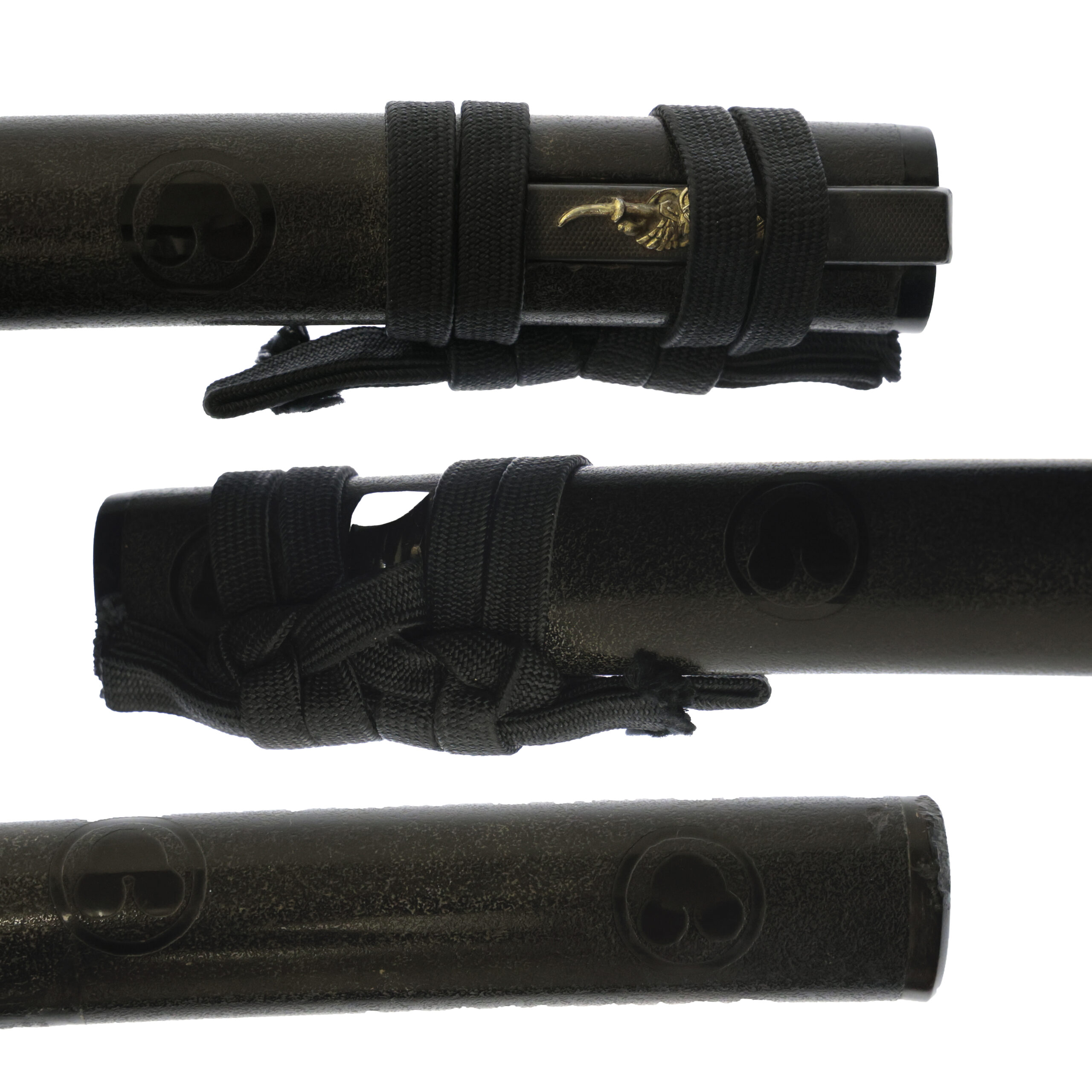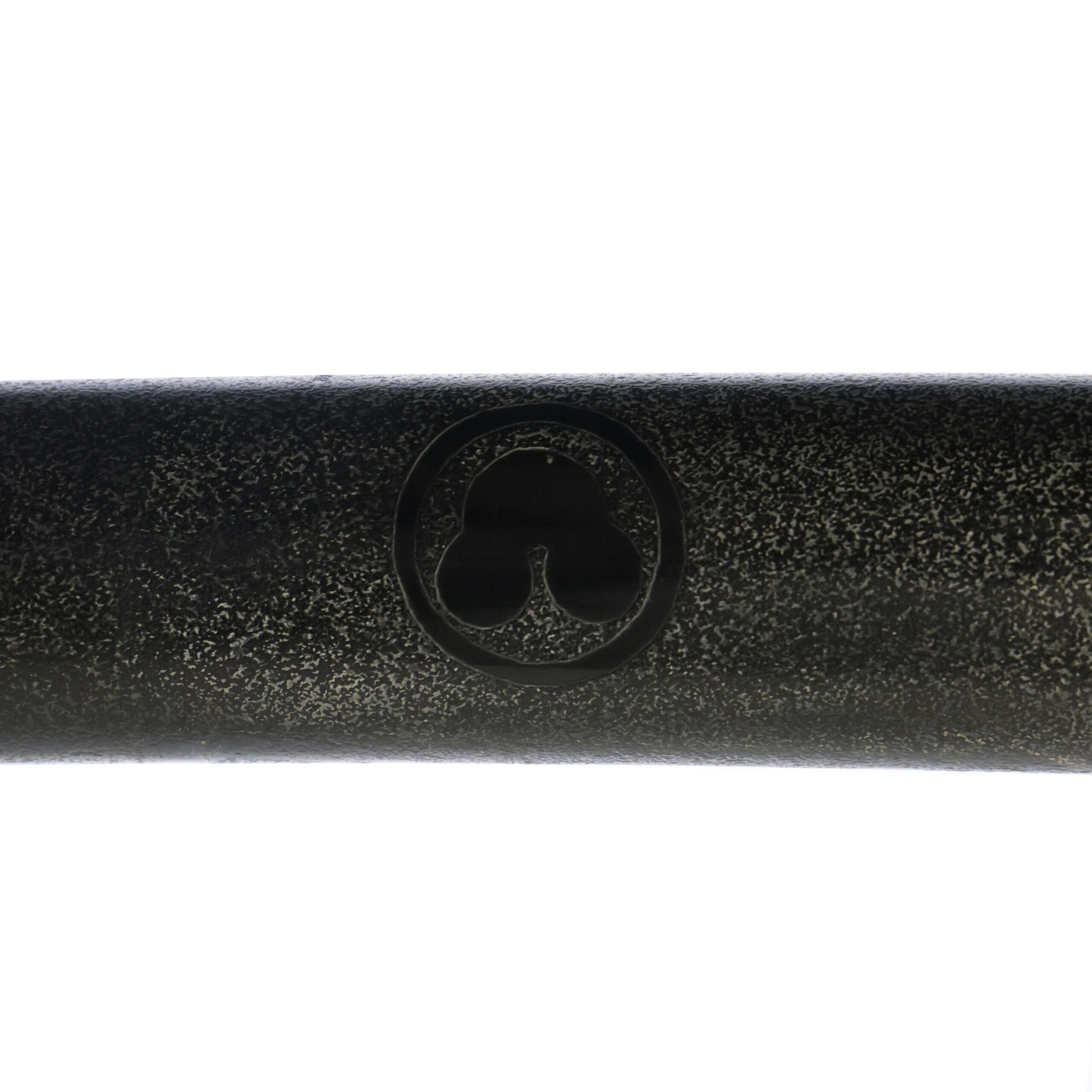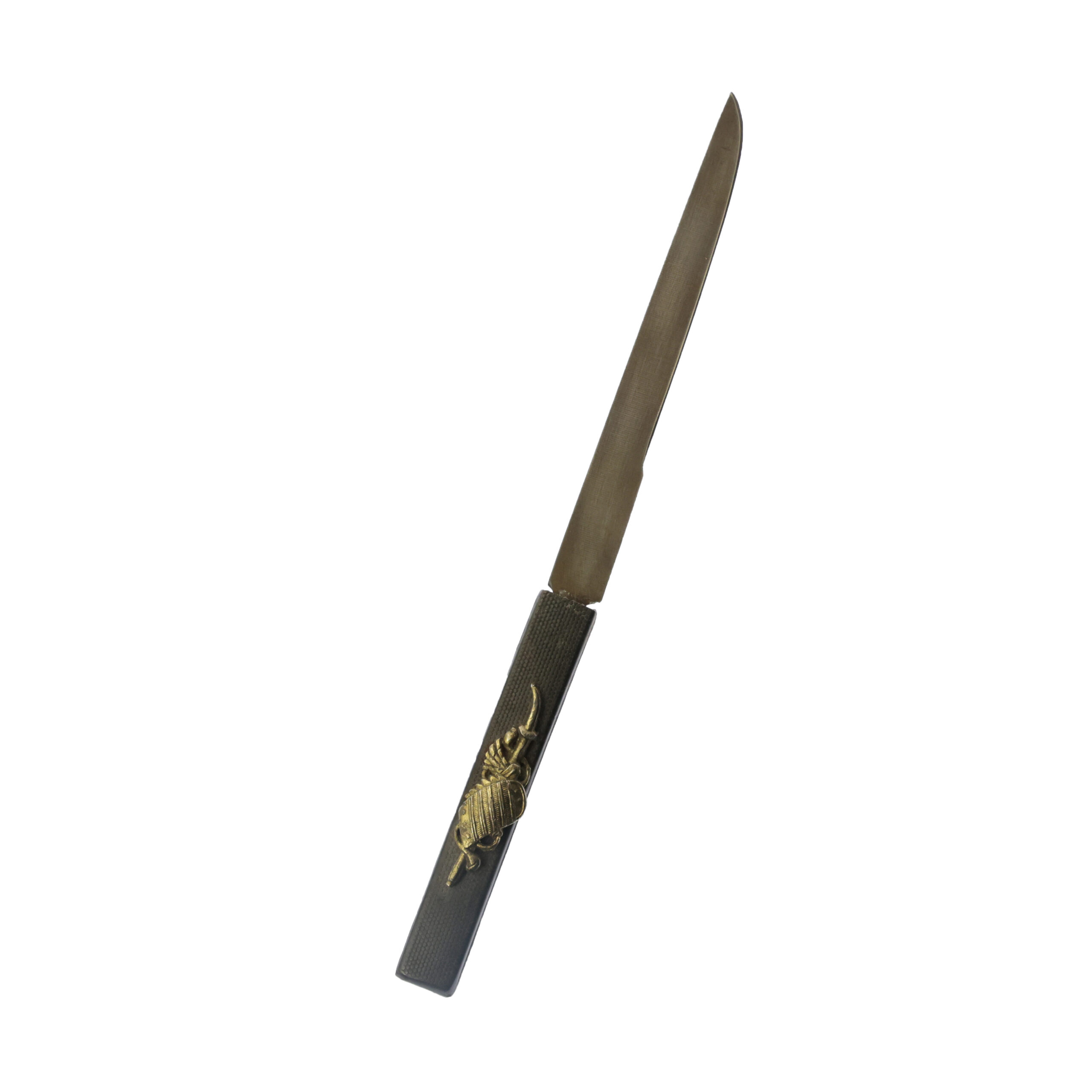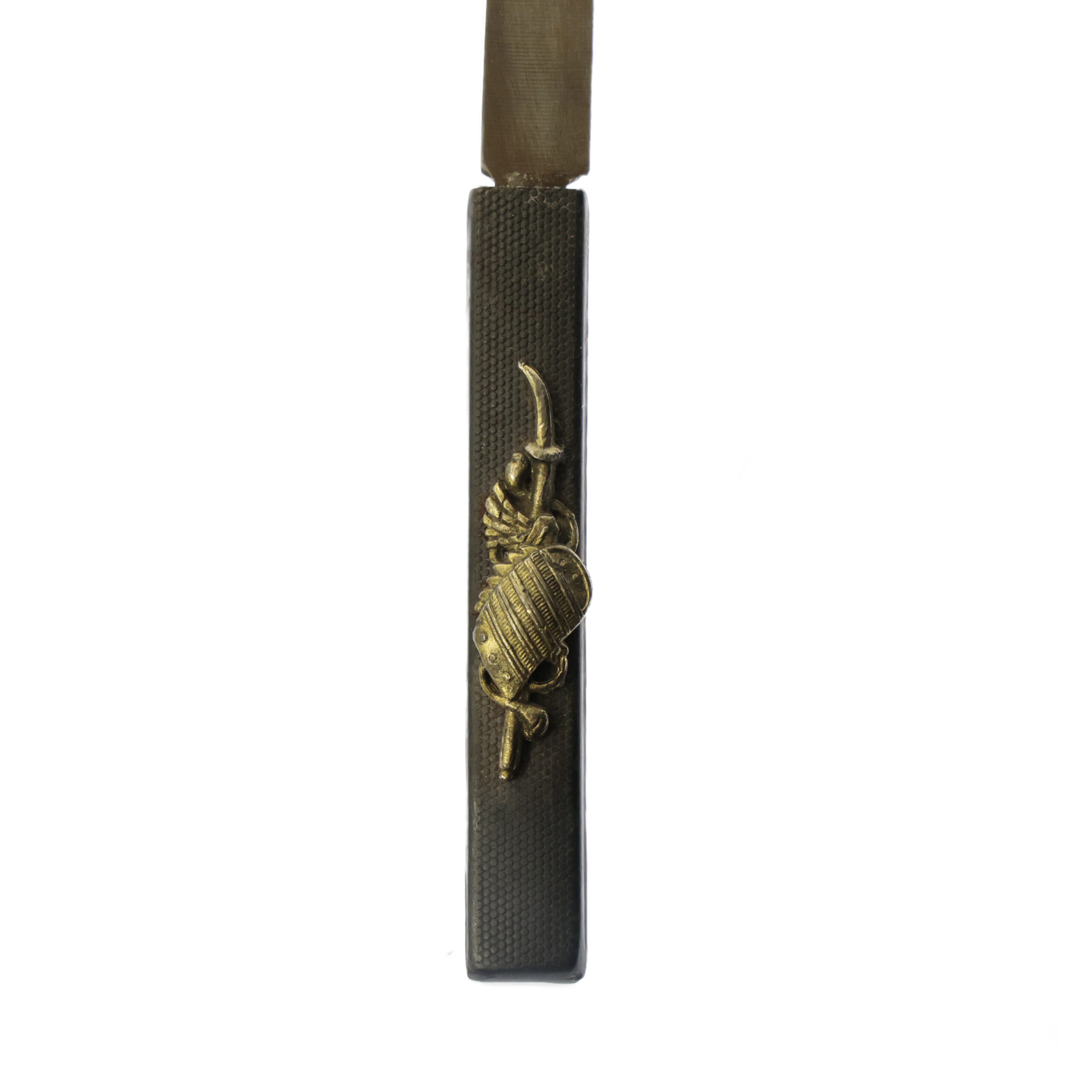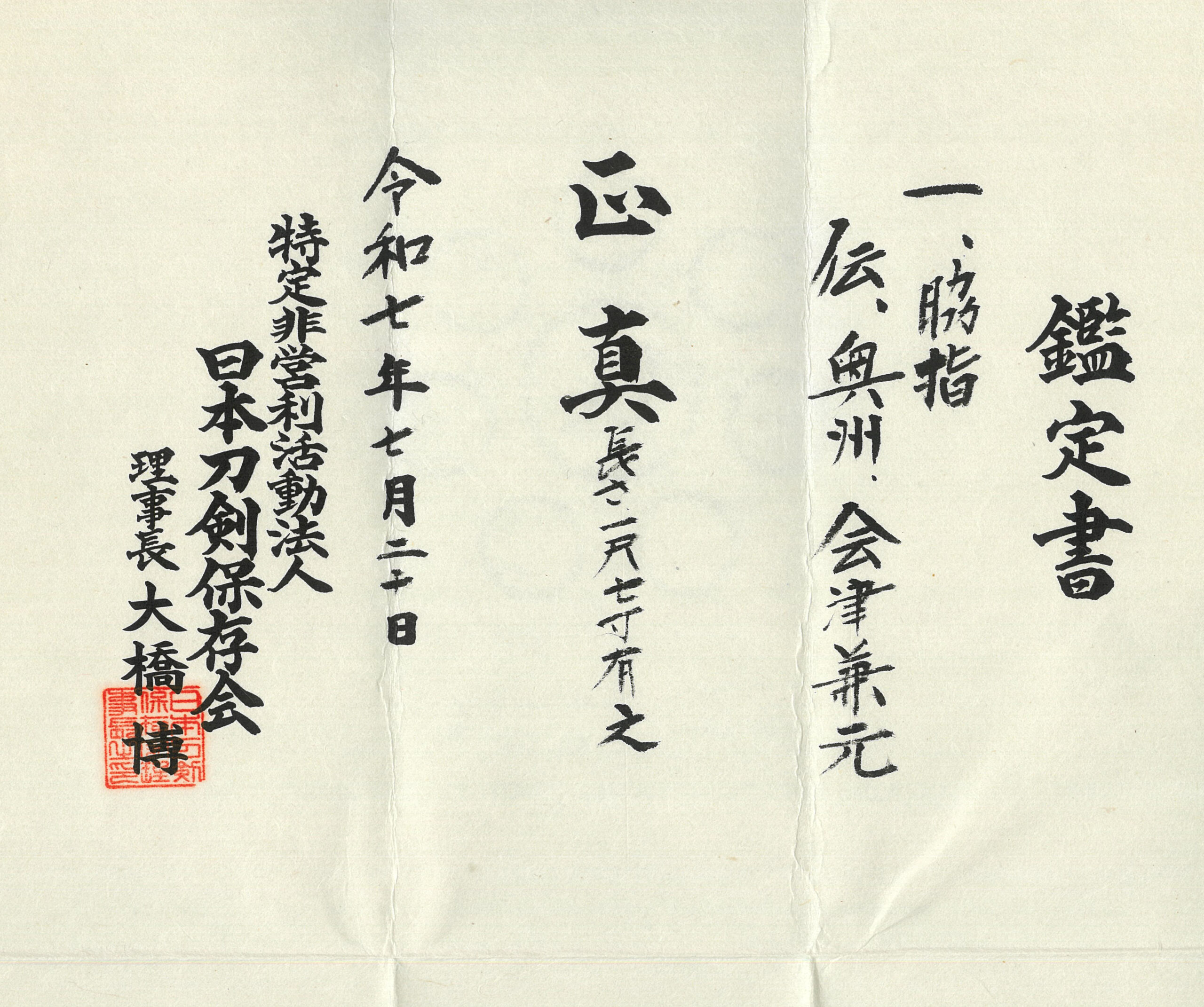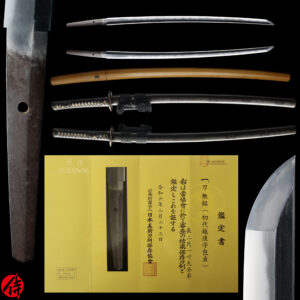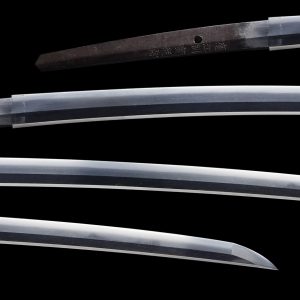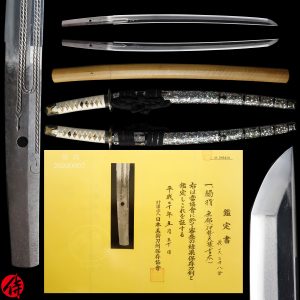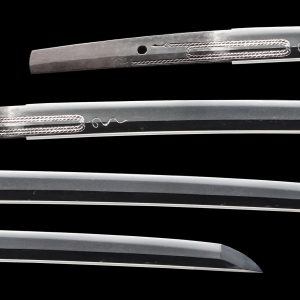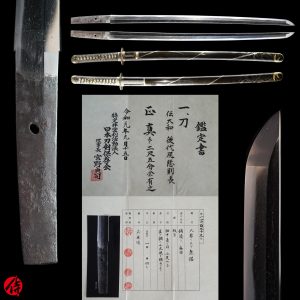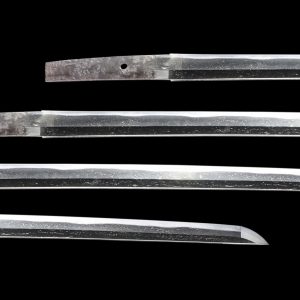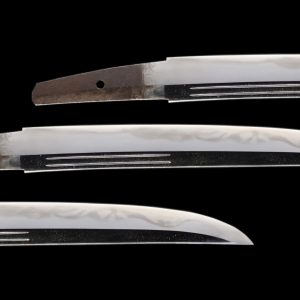Antique Japanese Sword Wakizashi Attributed to Oshu Aizu Kanemoto with NTHK Kanteisho Certificate
【Description】
This wakizashi is attributed to Oshu Aizu Kanemoto (伝 奥州会津兼元), dating to the Ansei era (1855–1860), late Edo period, according to NTHK.
Oshu Aizu Kanemoto is known as the 11th generation of the famous Aizu Kanesada line. His real name was Furukawa Seizaemon (古川清左衛門). In December of Bunkyū 3 (1863), he was granted the honorary title of Izumi no Kami (和泉守) and subsequently changed his signature to Kanesada (兼定). He had originally signed as Kanemoto, and from 1869 (Meiji 2) to 1874 (Meiji 7) he is recorded to have forged swords in Kamo, Echigo province (today’s Niigata). The 11th generation Kanesada (formerly Kanemoto) is particularly famous because his sword was the beloved blade of Hijikata Toshizō (土方歳三), vice commander of the Shinsengumi(新選組, a military unit formed as guards or Shogun at the end of the Edo period).
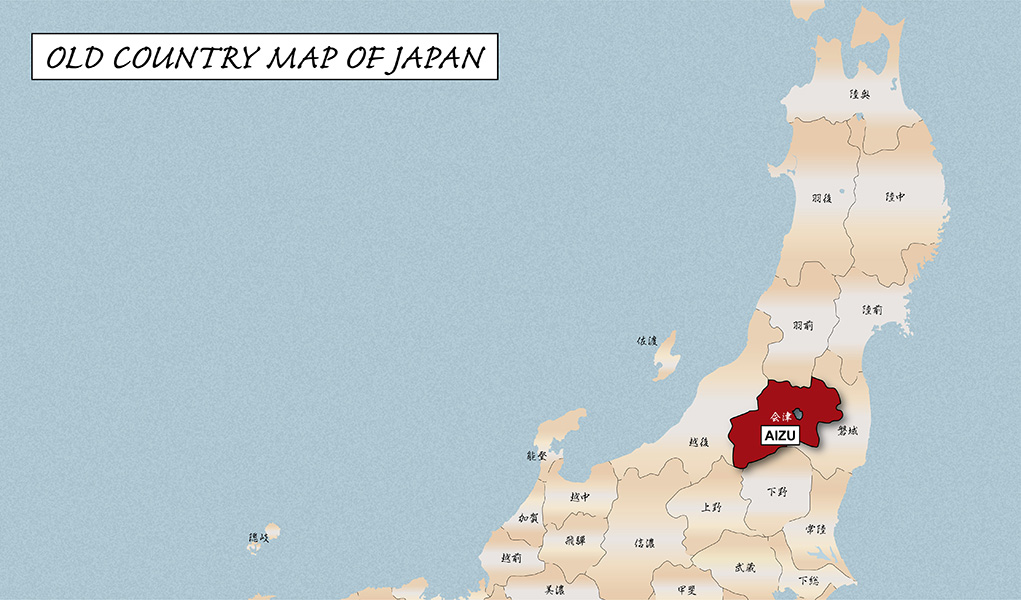
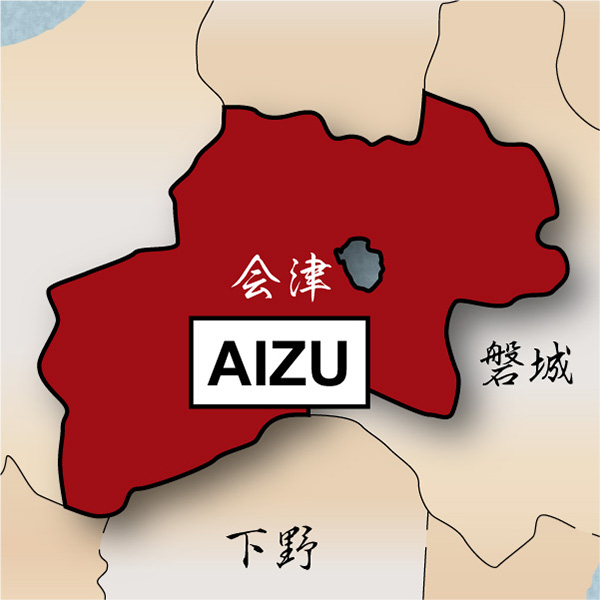
The Aizu domain, located in present-day Fukushima prefecture, was an important samurai stronghold during the Edo period. Known for its loyalty to the Tokugawa shogunate, Aizu also fostered a rich tradition of swordsmithing. The Kanesada lineage of Aizu is among the most renowned, producing blades valued for both their historical significance and quality. The strong association with the Shinsengumi, who played a dramatic role during the Bakumatsu era.
*Please keep in mind that there is a few Kitae Kizu and black rusts on the blade. If you like to see the detailed condition, please feel free to contact us.
【 Blade】
Cutting Edge Length(Nagasa):51.4 cm (20.2 inches)
Curvature(Sori):0.6 cm (0.23 inches)

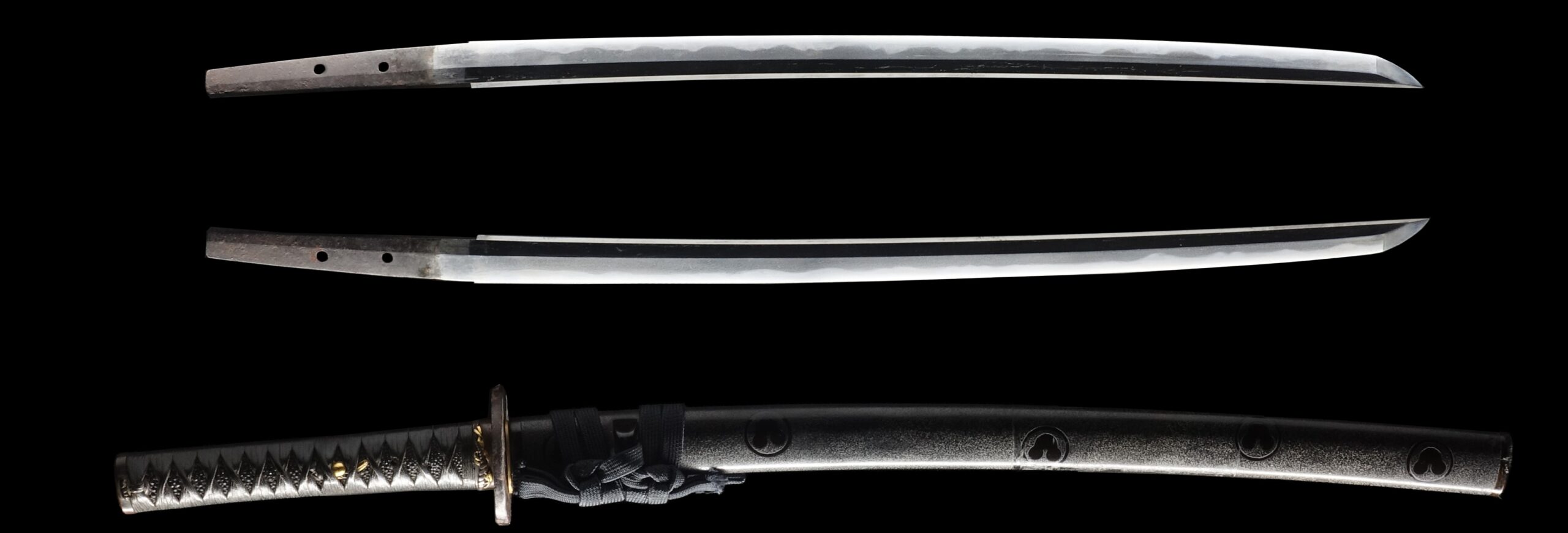
Hamon:
The crystalline structure which forms along the cutting edge of a blade as a result of the hardening process
Jimon(Jihada):
visible steel surface pattern created by folding and hammering during forging process
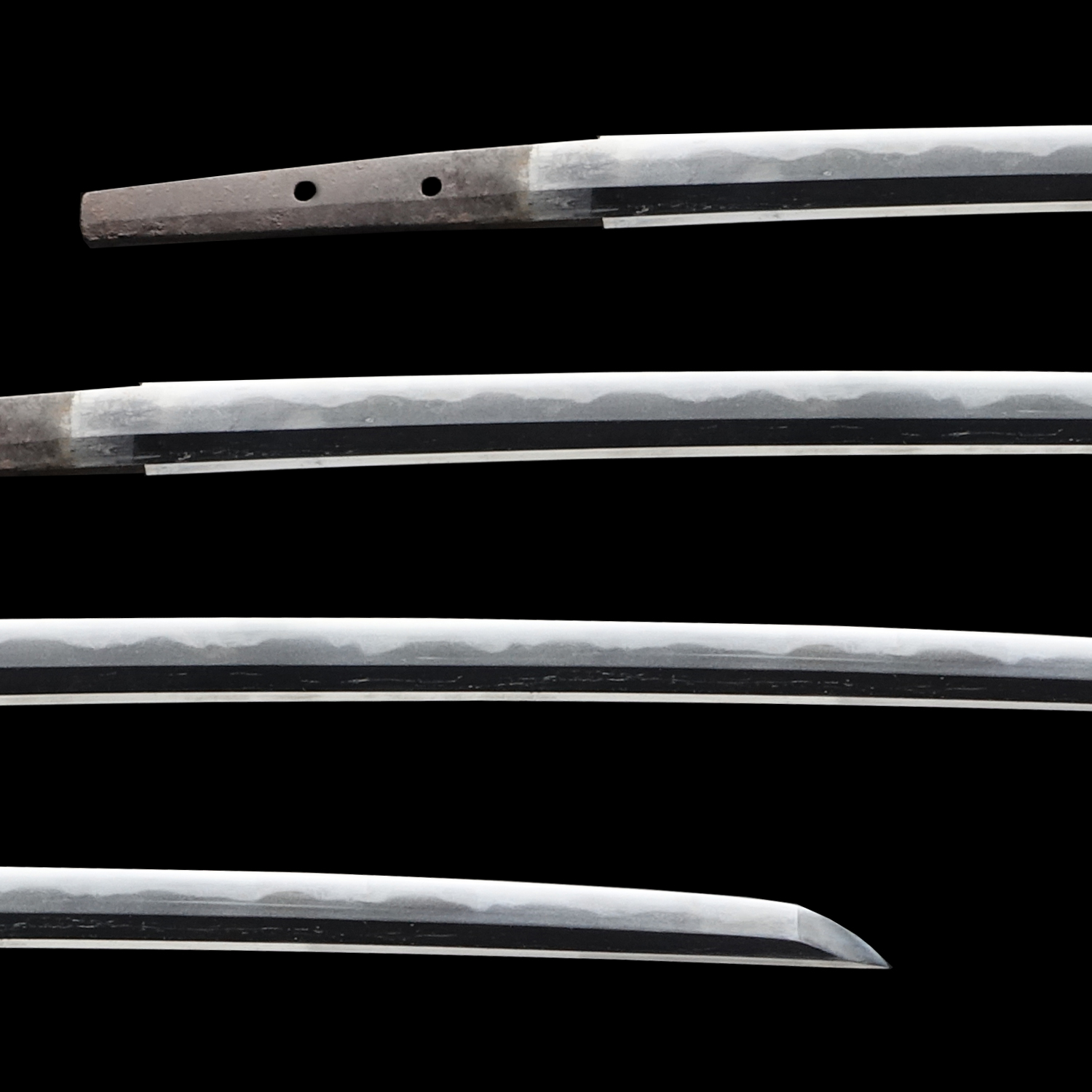
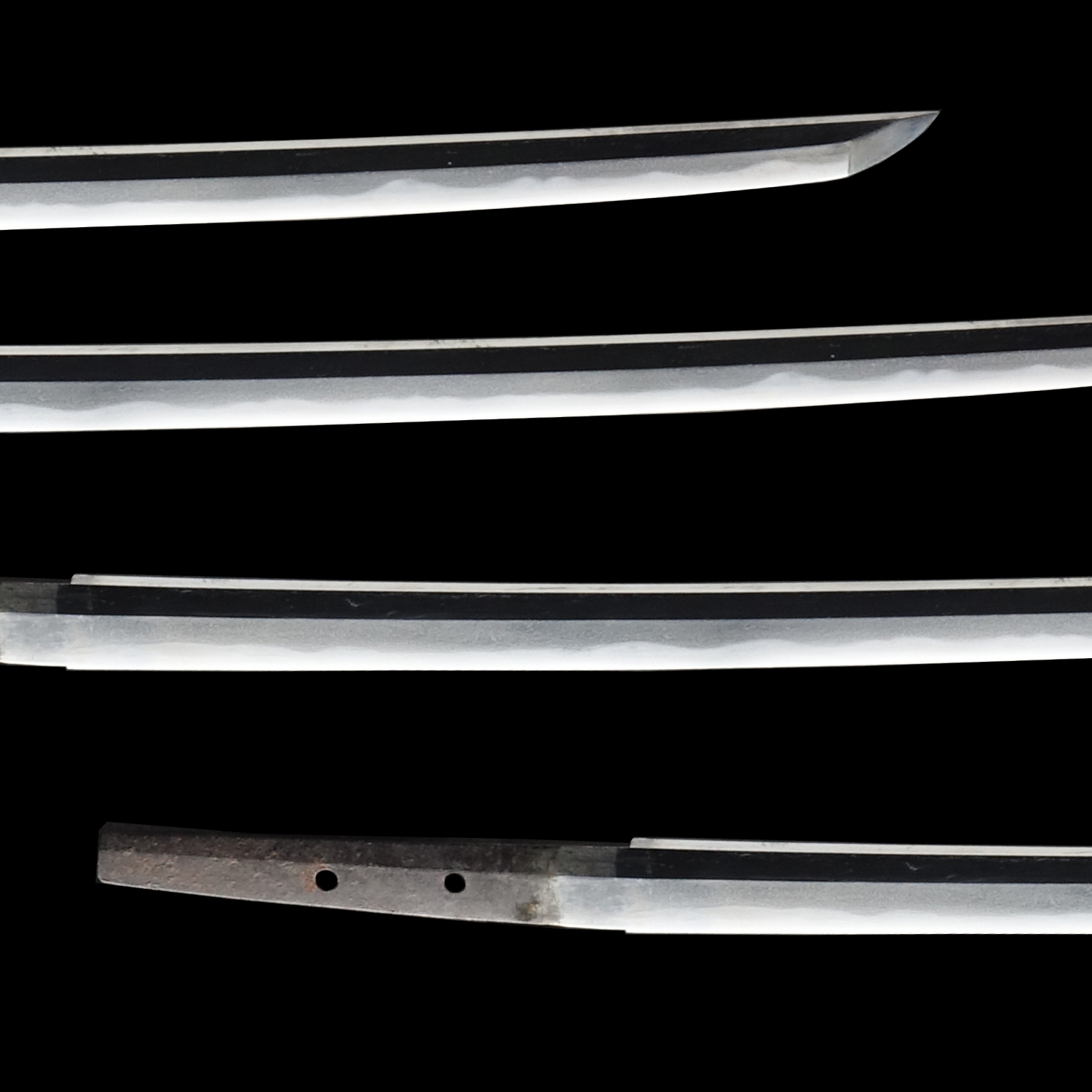
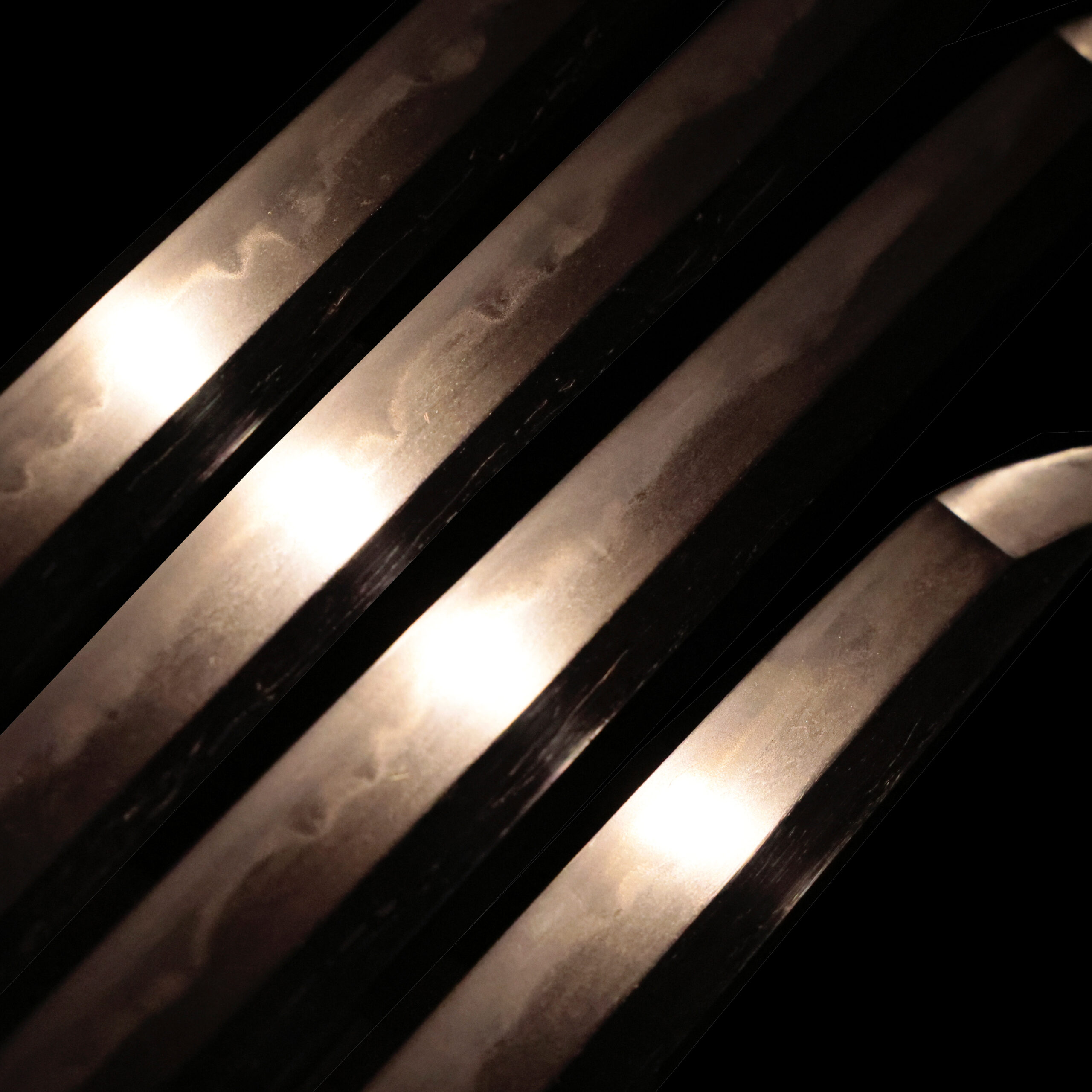
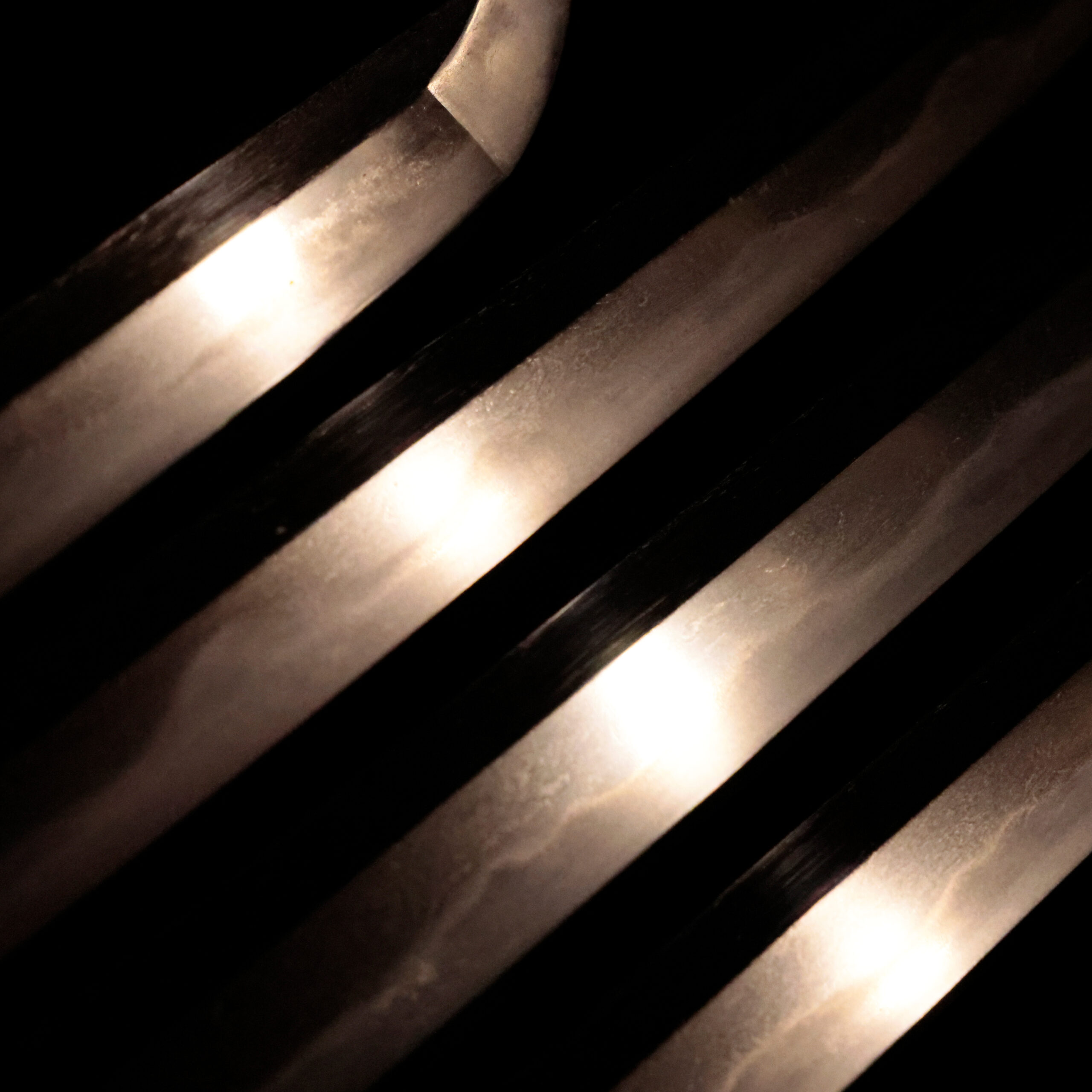
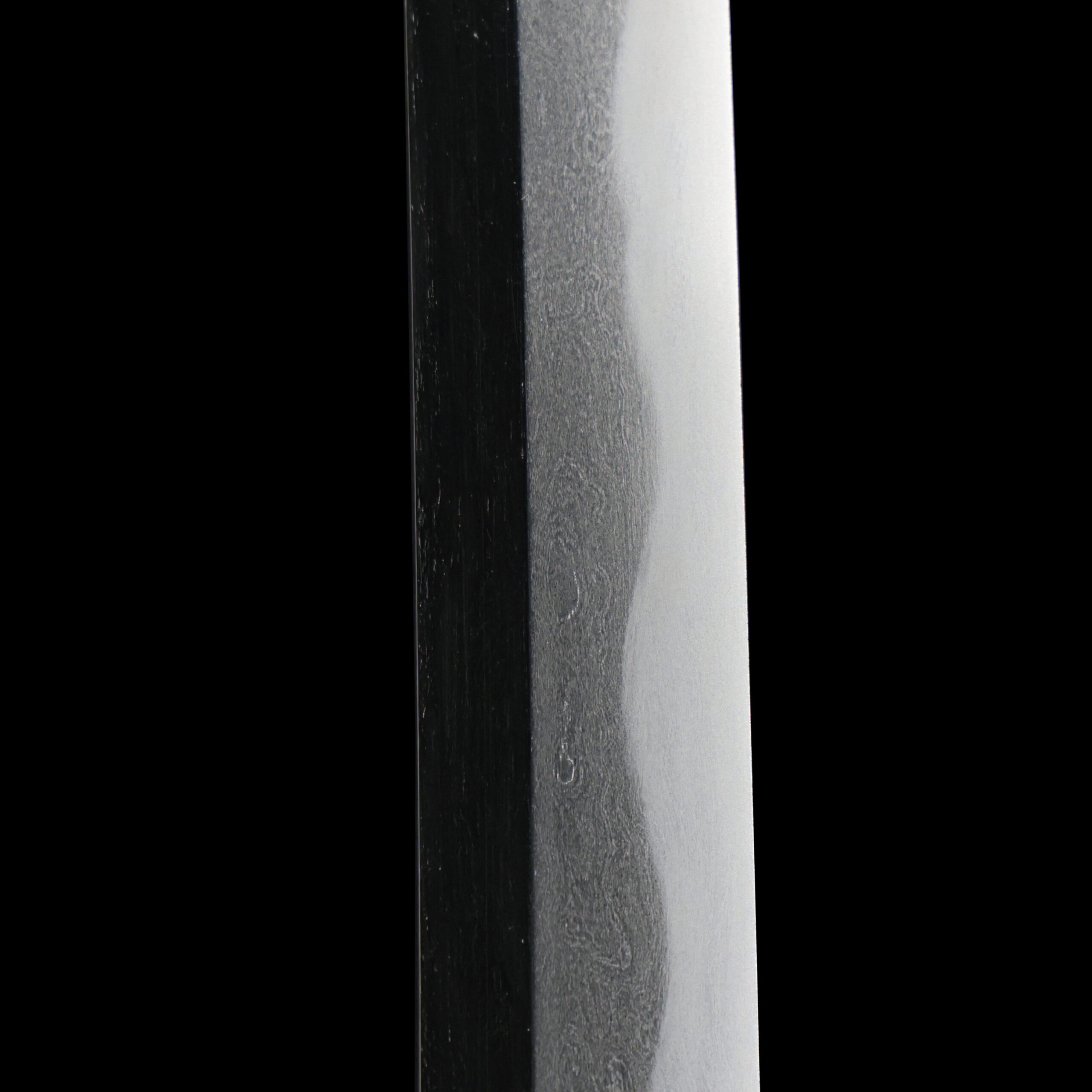
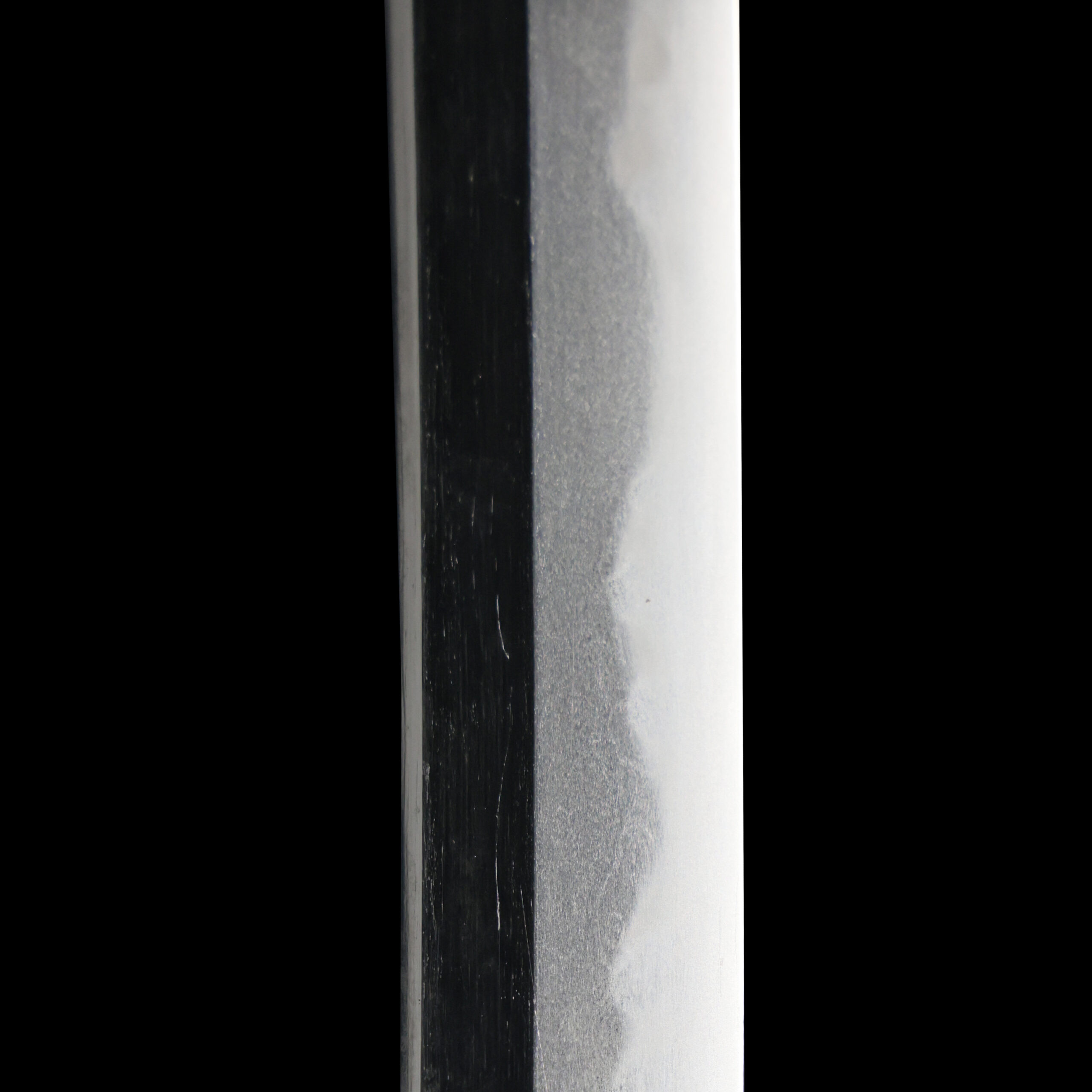
Kissaki:Kissaki is the tip of the Japanese sword.
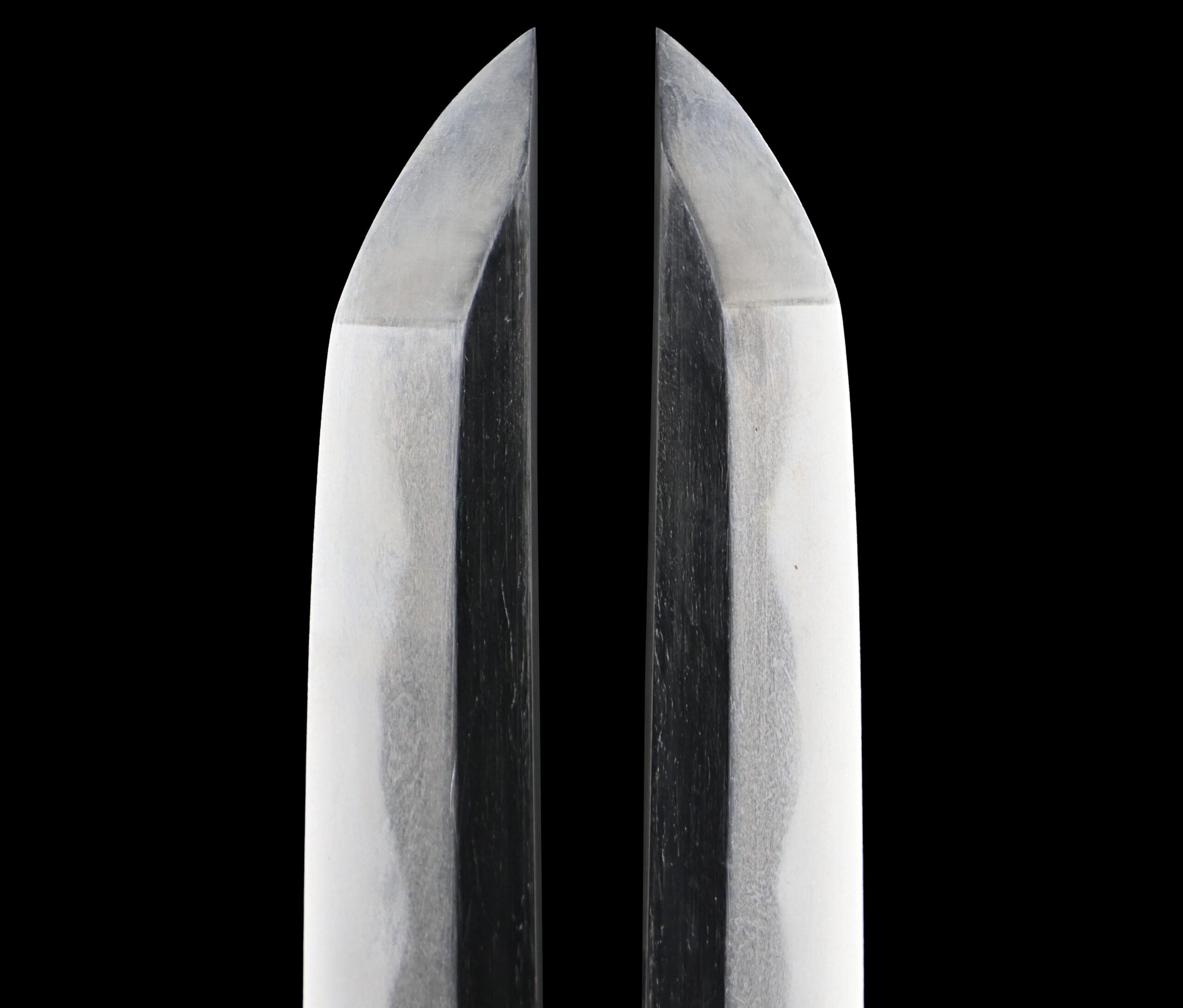
Nakago:Nakago is the tang of the Japanese sword.
Japanese swordsmiths left the black rust on the tang because it prevents red rust while the tang is in its handle. And the discoloration of the tang was created over time, and it is a great indicator for a Japanese sword specialist to estimate when the sword was forged.

Koshirae:Koshirae is the mounting of the Japanese sword. There are several parts that consist of Koshirae such as Saya (Scabbard), Tsuka (Handle), Tsuba (Handguard).
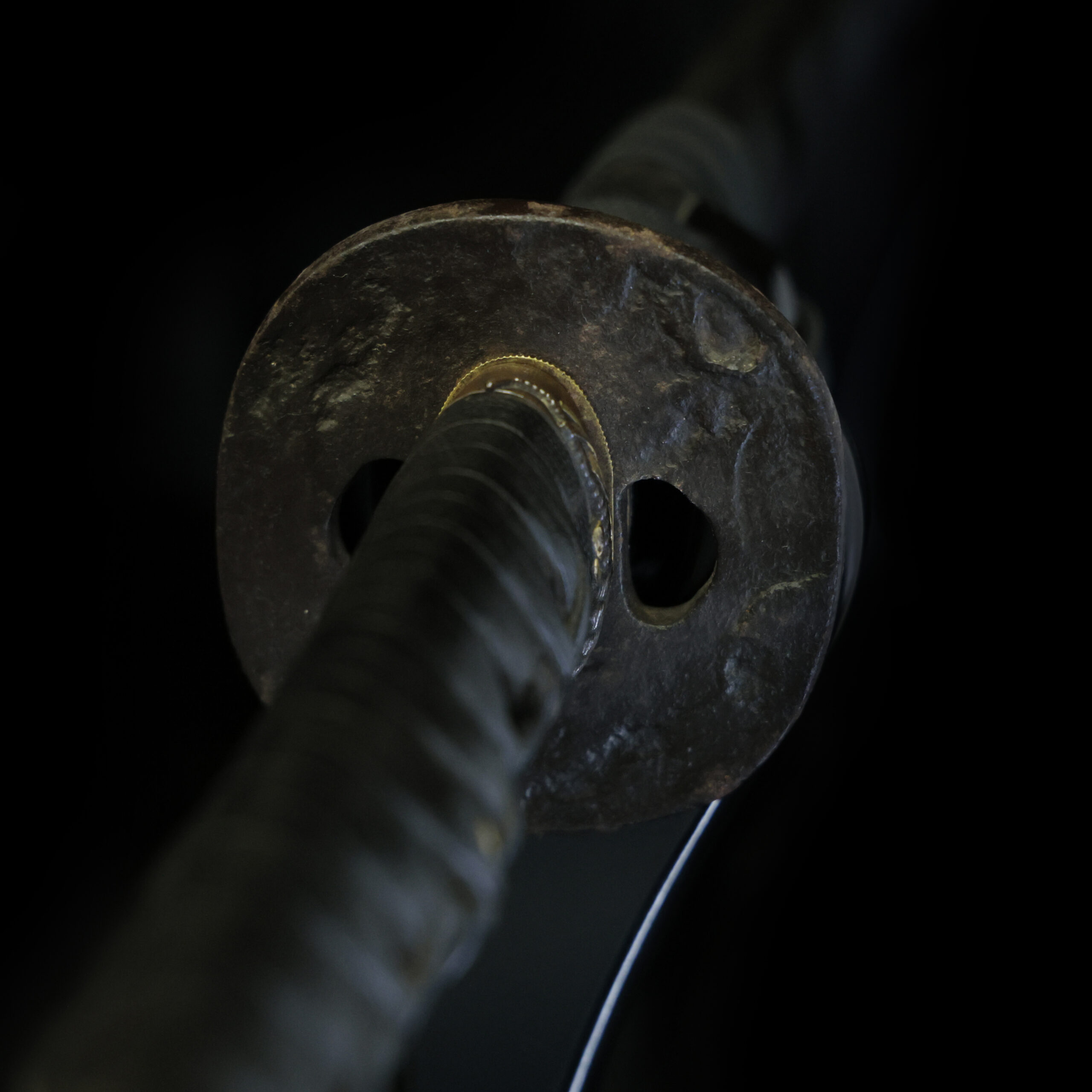
Fuchi-Kashira:A pair of matching sword fittings that cover the upper and bottom parts of its sword hilt.
This Fuchi Kashira is made from copper. The Ebi (海老, shrimp) and the Shimenawa (しめ縄, a sacred rope) are designed and inlaid with golden metal (probably brass). As these motifs are carved semi-three-dimensionally, it gives the reality that looks as if they were there.
According to a theory, Japanese people already ate shrimp in the Heian period (794-1185). However, it was expensive for ordinary citizens, so that only the nobility and high-class people could enjoy it. Today, shrimp is an indispensable ingredient for Japanese New Year’s cuisine. People started using shrimp as a good-omen pattern and appreciated designing it for their family crests in the Muromachi period (1336-1573). In Samurai’s society, as shrimp is covered with a hard shell, it was thought that shrimp represents the figure of a brave Samurai who wears the armor. Shrimp has been likened to an older adult because of its long feelers. Also, shrimps actively jump even though they are bowed. That is the reason why the shrimp pattern is treated as a symbol of perpetual youth and longevity.
Now please focus on the Fuchi part. You would find the “Shimenawa (しめ縄)” pattern. The Shimenawa is a decoration of a sacred straw rope that we could find in shrines. It is used as a barrier between the god area and this world. It is said it works for protection, meaning corrupted things cannot enter the inside of the border. We would say this Fuchi Kashira contains various positive items.
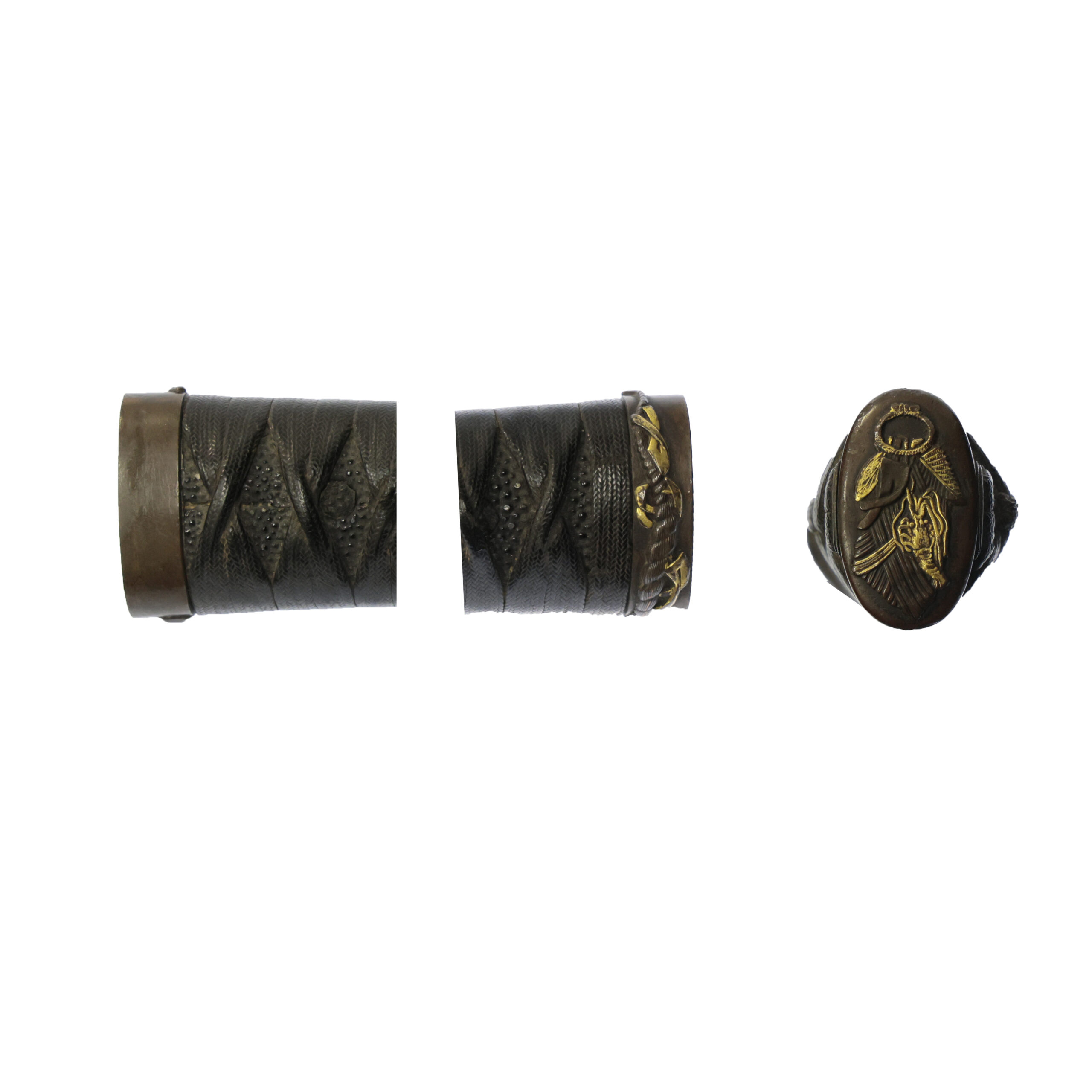
Tsuka and Menuki:Tsuka is the handle of the Japanese sword and Menuki is its decoration.
The motif of this ) is the same as that of the fuchi-kashira (縁頭): “Shimenawa (しめ縄)” pattern. This consistency in theme creates a strong sense of visual unity across the sword mountings.

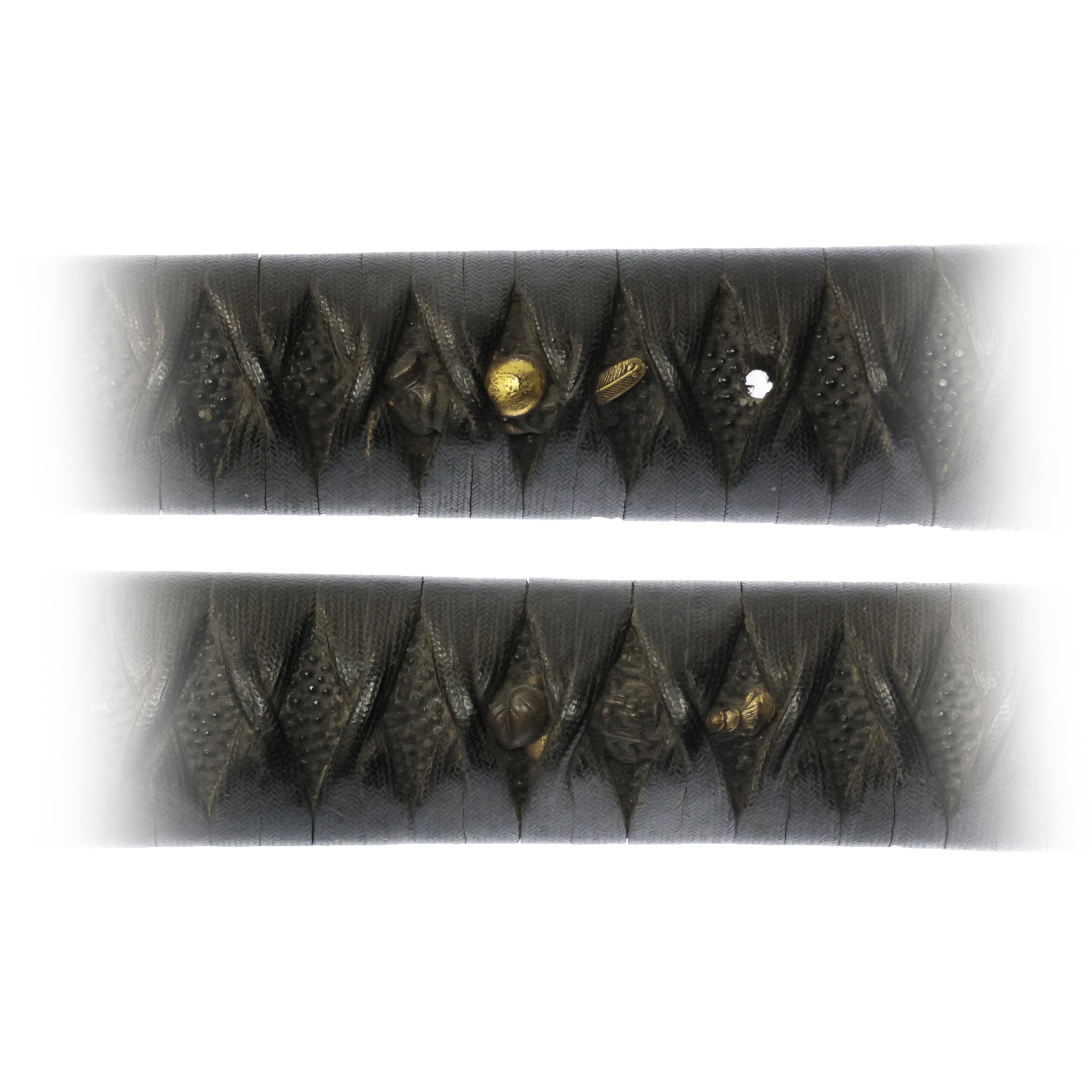
Tsuba and Habaki:Tsuba is the handguard for the Japanese Sword and Habaki is the equipment to make the blade not touch its scabbard inside. It prevents the blade from getting rusty and chipped.
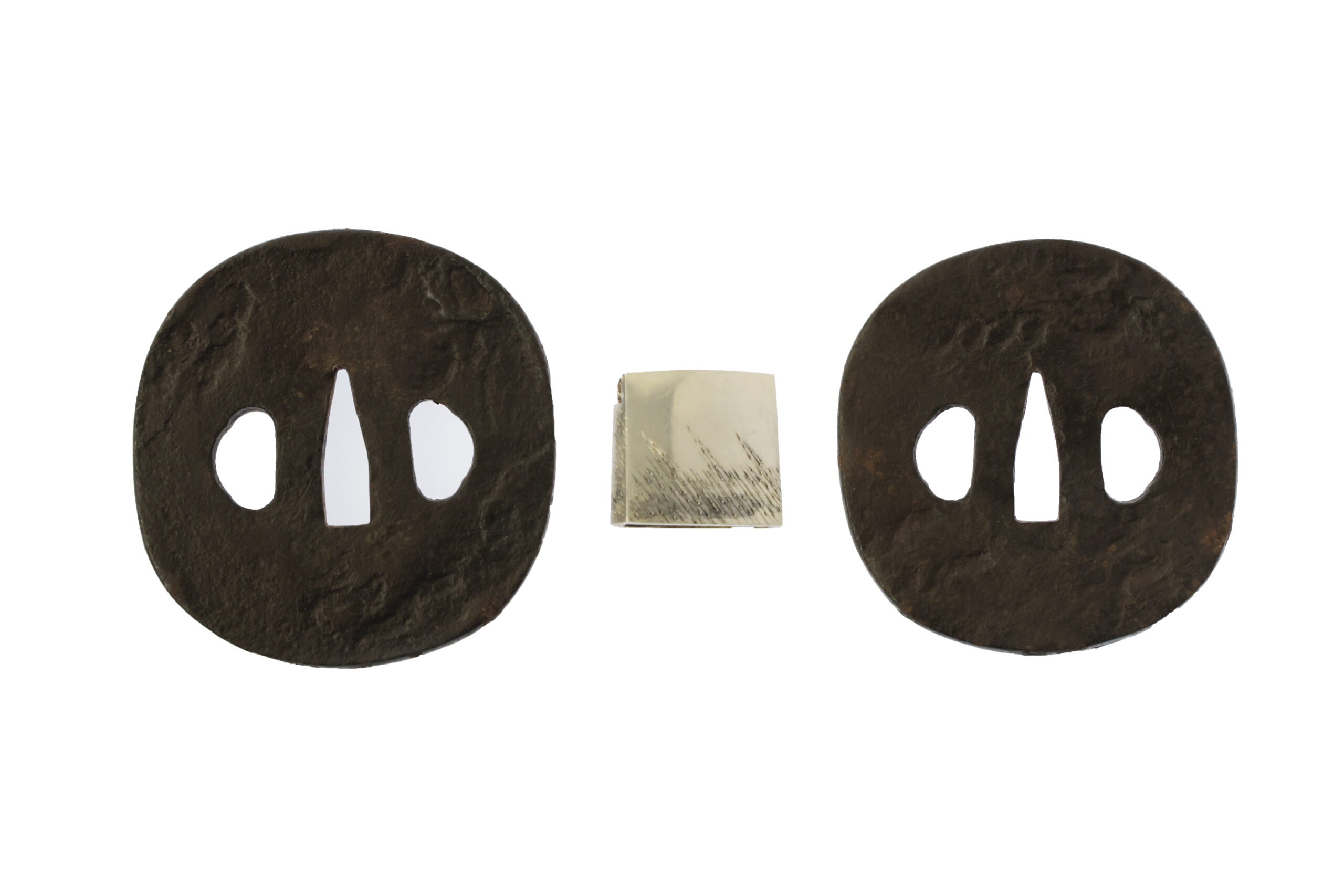
Kozuka: Kozuka is a small knife stored in Kozuka Hitsu(groove of the sheath of the Japanese sword).
The motif of this kozuka (小柄) depicts various pieces of samurai weaponry and armor, including a naginata (薙刀, polearm) and protective gear. The naginata is a traditional Japanese polearm with a long, curved blade mounted on a shaft, historically used by both samurai warriors and warrior monks. It was valued for its versatility in combat, allowing for sweeping strikes as well as defensive maneuvers. Such motifs were not only decorative but also symbolic, evoking the martial spirit of the samurai and reflecting the warrior ethos deeply rooted in Japanese culture.

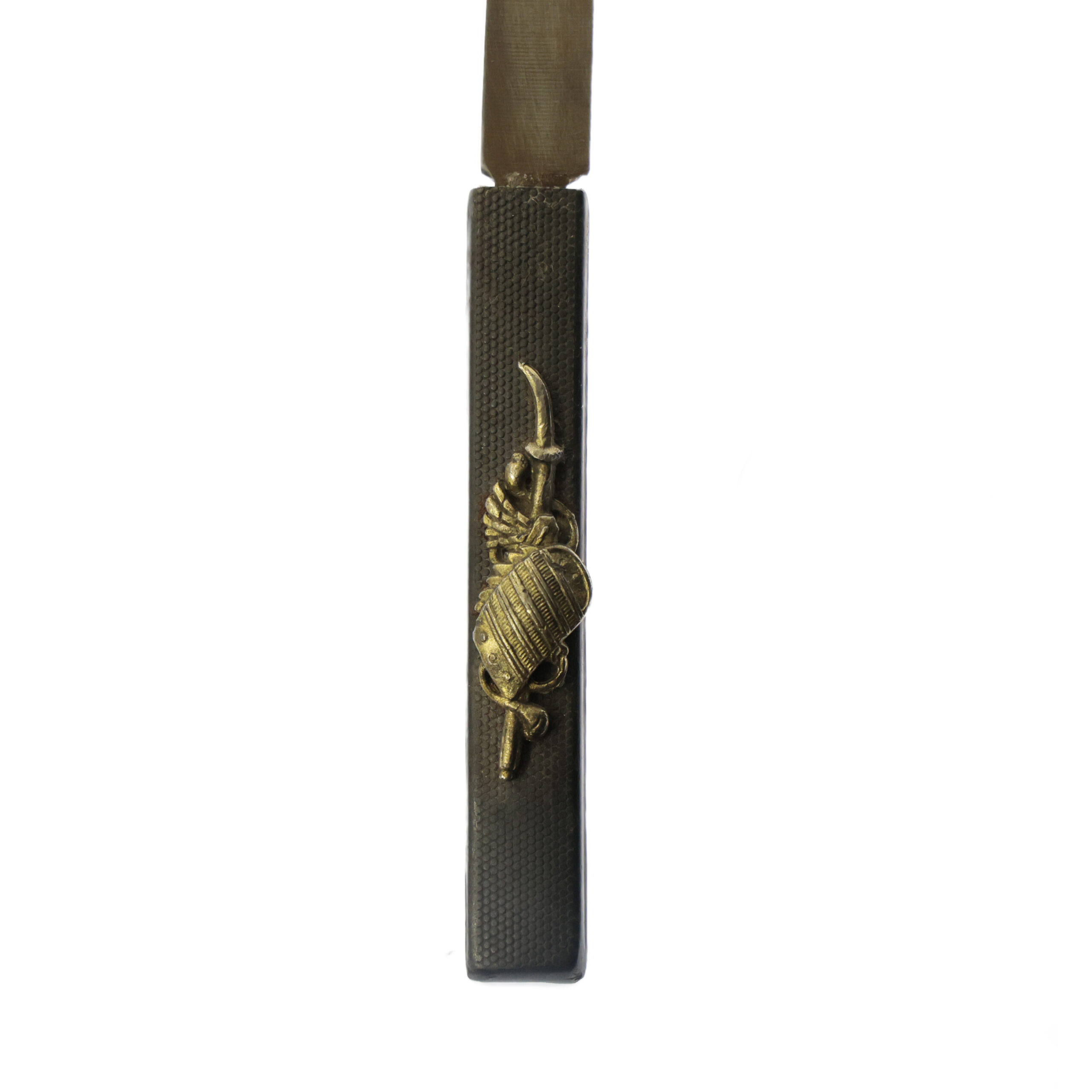
Saya:Saya is the scabbard for the Japanese sword.
The motif depicted on the saya is the Japanese family crest known as the Suhama-mon(洲浜紋). Suhama refers to a landform created by sand or gravel accumulating in a curved, beach-like shape along rivers or the sea. Over time, this form was stylized into a decorative motif, often used in celebratory furnishings such as suhama no shimadai (island stands for festive occasions). The crest also appears in variations combined with auspicious elements, such as pine trees (松, matsu) or plovers (千鳥, chidori), reinforcing its association with good fortune and celebration.
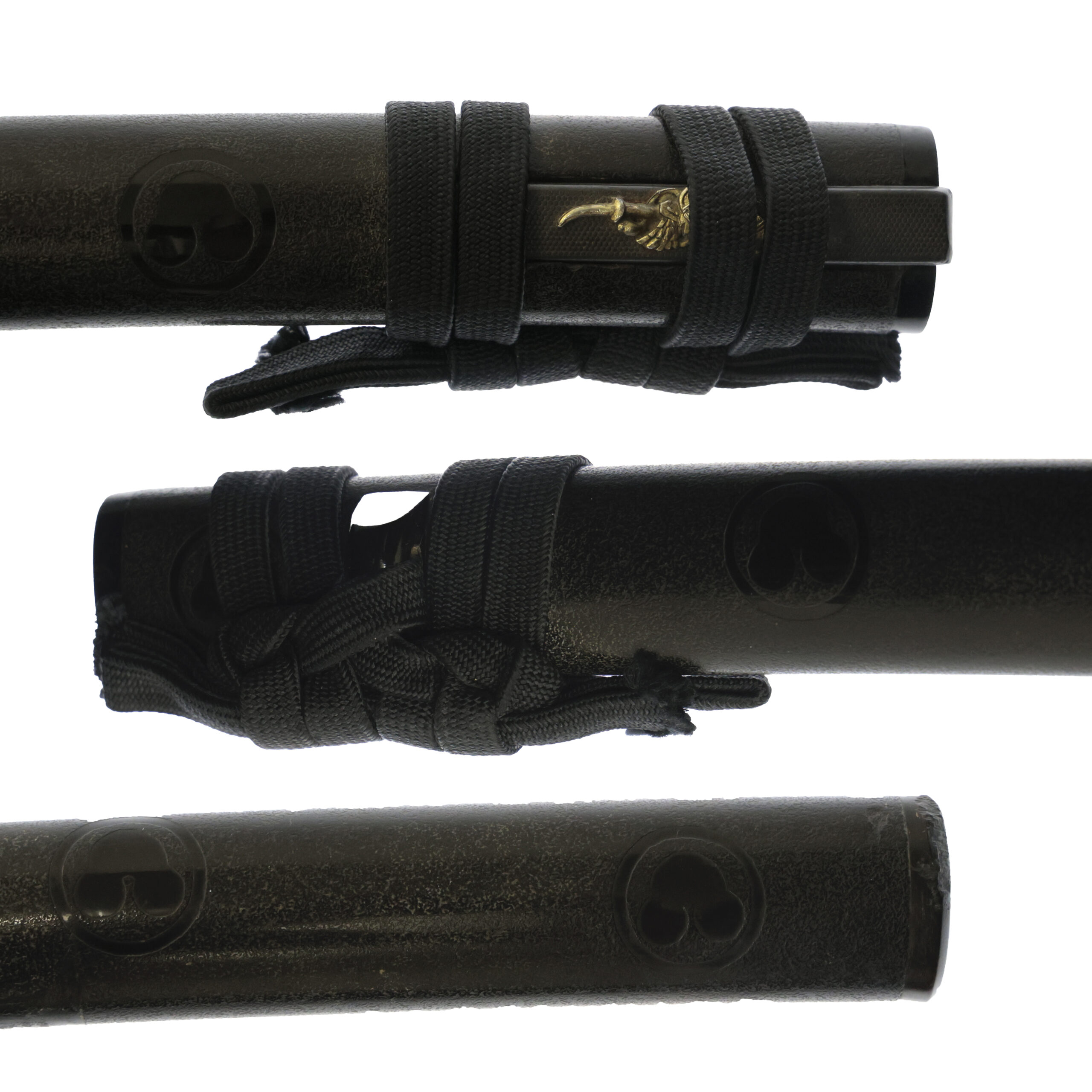
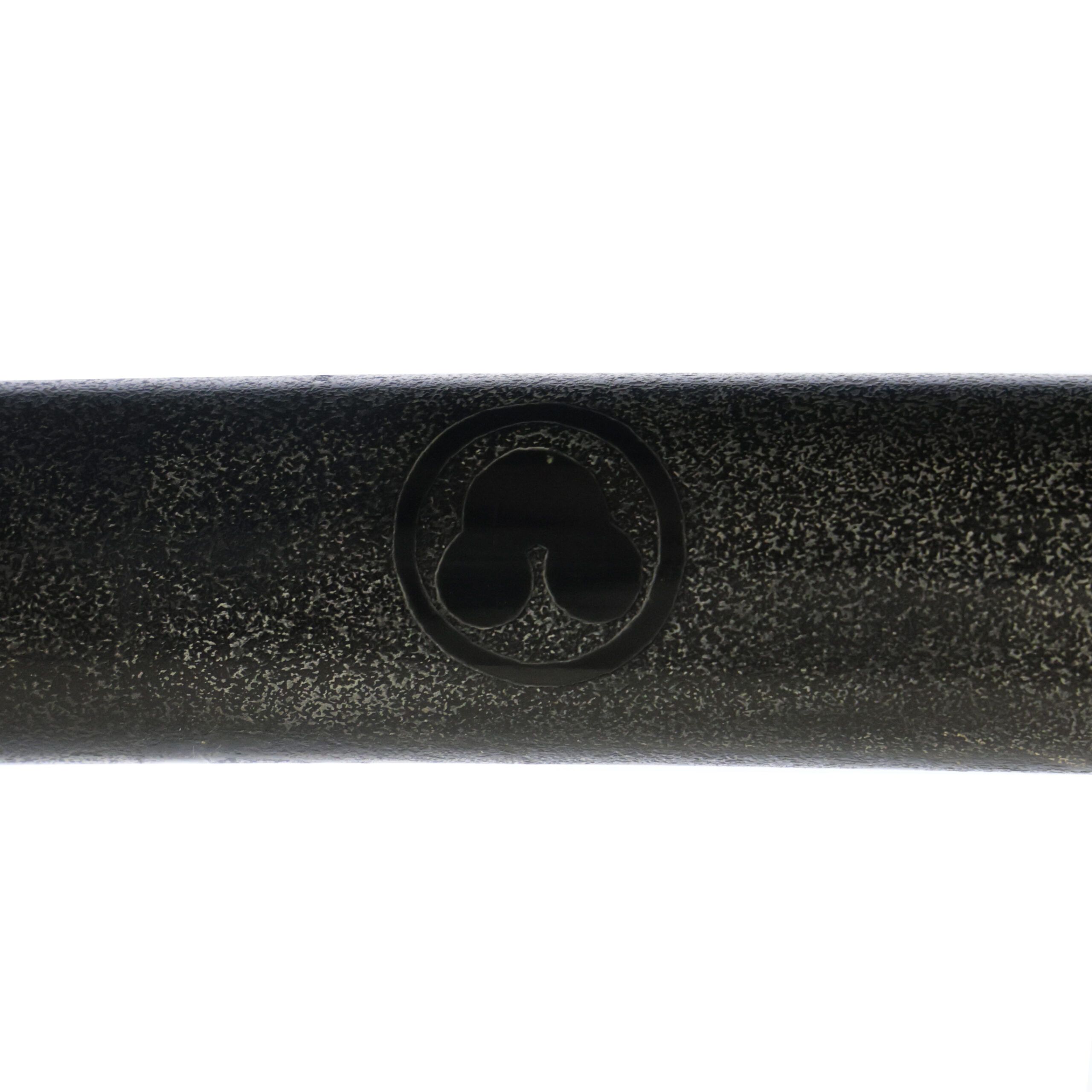
Authentication Paper:NTHK Kanteisho Certificate for the blade (No. 13286)
NTHK, also known as NPO Nihon Touken Hozon Kai, is the oldest organization for sword authentication of Japanese swords in modern times. It was established in 1910 during the post-Samurai era. They authenticated the blade on July 20st in the 7th year of Reiwa (2025). The purchaser will receive this original certificate as well. We can also translate what is written into English and make a PDF file for your record if you request.

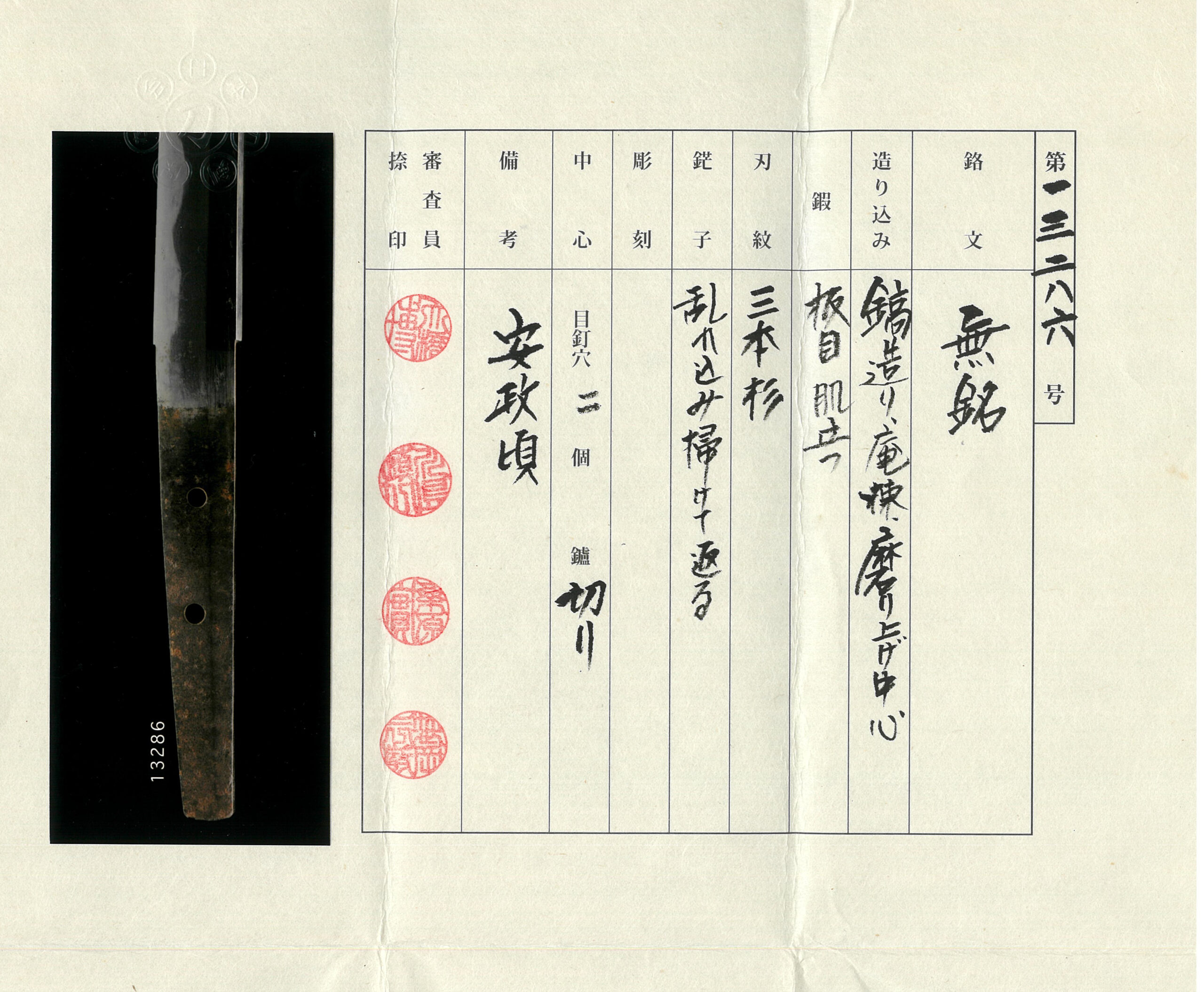
Registration Number : Fukushima 15042
The Board of Education in Fukushima prefecture issued a registration paper for this sword. It is called Jyu Token Rui Torokusho (銃刀剣類登録証). Bunkacho (The Agency for Cultural Affairs) acknowledges a Japanese sword with this paper as a work of art.
The sword needs to be traditionally hand-forged and made of Tamahagane carbon steel to be registered in the system. With this paper, its owner in Japan can legally own an authentic Japanese sword. Based on this registration number, we will apply for its export permit.
This paper will need to be returned to the board of education when the sword is being shipped abroad, but you can receive a copy of it. An English translation of this registration paper is available on request.
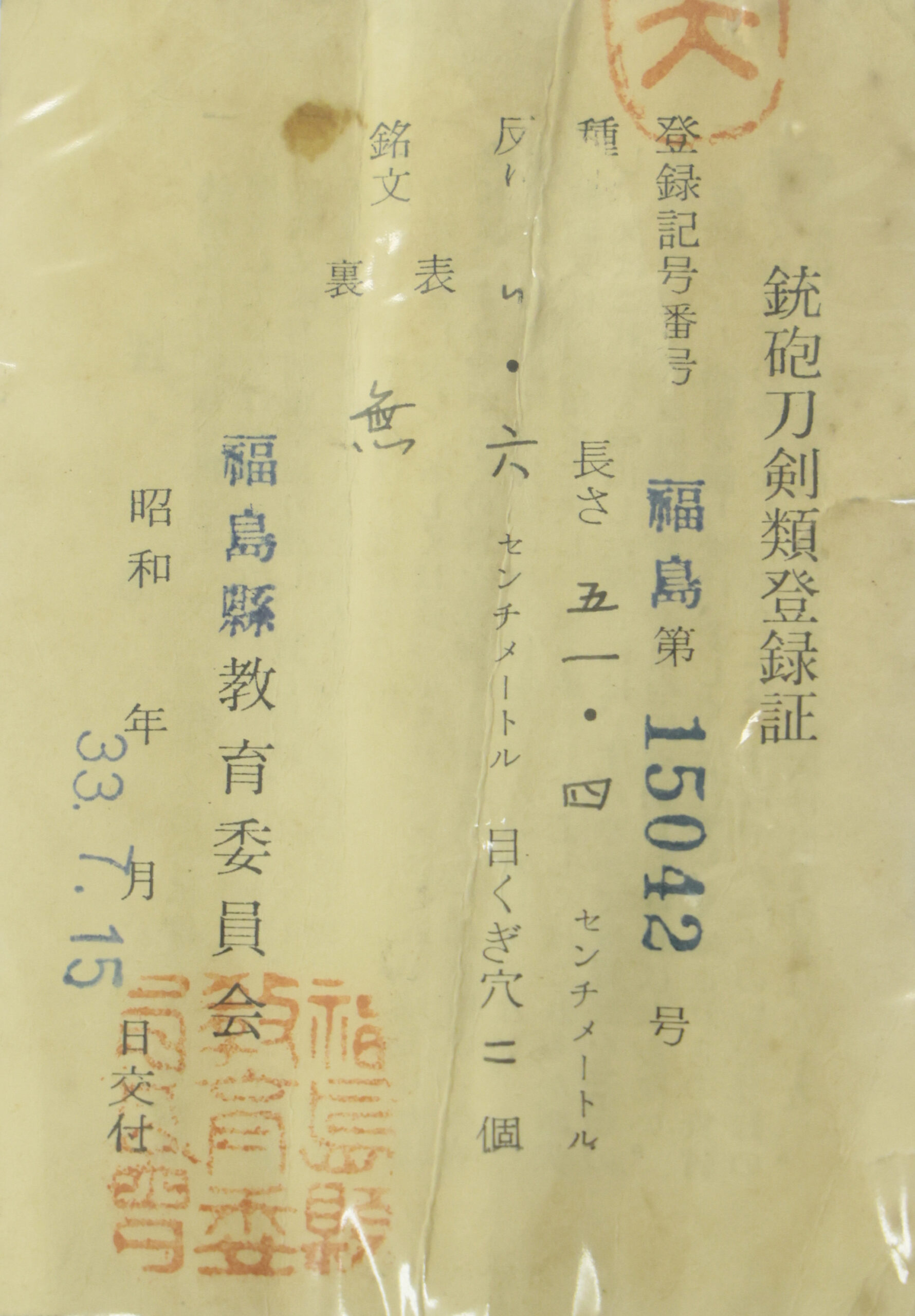
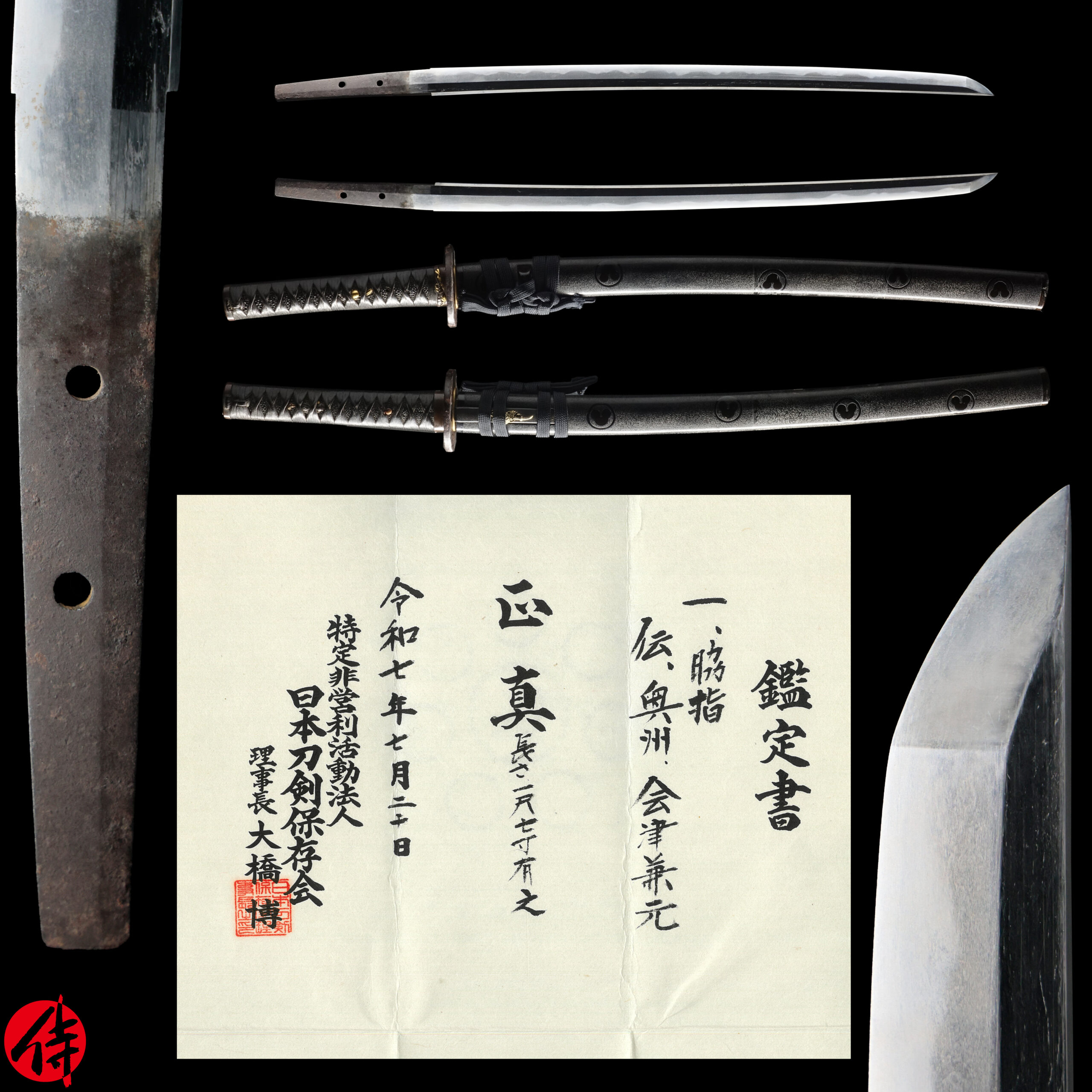
—————————————————————–
【About us】
Samurai Museum is located in Tokyo, Japan, exhibiting antique artifacts related to the Samurai history. Samurai Museum Shop is the place for those who are interested in Japanese culture and craftsmanship. We deal with antique Samurai swords/armor, traditional crafts made in Japan and so on.
【Japanese Sword& Export Process】
The Japanese swords we deal with are hand-forged edged swords made in Japan. It was made from the traditional carbon steel called TAMAHAGANE(玉鋼). Samurai Museum is familiar with the proper legal procedure for an antique/ authentic Japanese sword to be exported from Japan. We have sent more than 700 Japanese swords for the past few years (~2024) to amazing owners who appreciate its historical value.
Each Japanese sword is registered under the Agency for Cultural Affairs and the Board of Education in Japan. They issue a registration paper for each Japanese sword for its owner in Japan to legally possess it. The Japanese sword with its registration paper means it was traditionally hand-forged in Japan.
To legally export the sword from Japan to other countries, we will have to apply for its permit to the Agency for Cultural Affairs(Bunkacho) and return the original registration paper to the Board of Education. It normally takes around 2-4 weeks to receive this permit after submitting required documents. And we would like you to expect at least 1-1.5 months for your order to arrive at your given address after you ordered. For more detailed info, please click here.
It is allowed for residents in Japan to own authentic Japanese swords without a special license as long as they come with registration papers. Please feel free to contact us if you are a resident of Japan, whether temporarily or permanently. We will also assist you when you leave Japan and need to obtain the export permit.
【Payment Method】
We accept payment through Stripe (Credit card), PayPal, Apple Pay or ChromePay, all of which are secure payment methods. Also, you don’t need to make an account on Stripe for the checkout. If you prefer other payment method, please contact us. After confirming your payment, we will apply for an export permit. You may either pay in JPY, USD, AUD, CAD,EUR CHF or GBP. The price is set in Japanese Yen. Prices in other currencies are automatically calculated based on the latest exchange rate.

* If the amount is above 1 million JPY, Stripe or wire transfer will be the only options for payment.
【Shipping】
We have shipped authentic Japanese swords to the USA, Canada, Mexico, Germany , Belgium, France, Finland, UK, Hong Kong, Australia. If you don’t live in these countries and like to order, please contact us first before making a purchase. We offer Free International Shipping as long as we can send antique Japanese swords by EMS.
We normally ship by EMS(Express Mail Service) provided by Japan Post. We will send you a tracking number for your order as soon as we hand it to the post office. We will put 100 % insurance on the shipping document without any extra charge. Based on the total amount, there might be a duty tax or other fee for you to pay, depending on the countries. We use package cushioning to protect the item and put it in a PVC pipe, which is one of the most secure packages because of its durability.
It will normally takes 5-14 days for the item to arrive at your given address after we dispatch it. Time of delivery is estimated as accurately as possible by the carrier but does not take into account any delays beyond our control such as by inclement weather, post office holiday seasons.
* If you live in Australia and like to purchase an authentic Japanese sword, please click here to know the detail.
* If you live in the UK and like to purchase an authentic Japanese sword, please contact us first and click here to know the detail.

【Review】
Here is one of the reviews we received from a customer who purchased an authentic Japanese sword from us. For more reviews, please click here.
“My experience overall with the whole process was wonderful. I had many questions about the history and process to purchase these treasures. All my questions were answered very timely and complete. The staff is very knowledgeable and very well versed if any questions do arise.”
【How to make sure the condition】
Please keep in mind that what you are going to purchase is an antique item. We uploaded high resolution photos for you to check its condition thoroughly. If you like to see more photos with different angles, please feel free to contact us. We will be happy to send them to you so that you can make informed decision. It is essential for us to know that you are happy with your choice of a sword. and we are prepared to use the best of our ability to serve you.
【How To Contact Us】
Please contact us through email, Facebook Messenger or Live Chat if you have any questions. You can find each icon on the right side of the website. Please click one of them to reach us. We will reply to you within 1-2 business days.
【The Art of Nihonto (Japanese Sword)】
Samurai’s history is a profound, eloquent legacy of ancient Japanese warriors in which millions of people worldwide are being fascinated. If you like to find out the art of Nihonto, please click here.
【A Guide to Japanese Sword Maintenance】
After acquiring an genuine Japanese sword, it is also important to know how to take good care of it. Here is the special video for you. Mr. Paul Martin, Japanese sword expert, shows you how to give proper maintenance to your sword. By mastering how to clean the Japanese sword, its aesthetic beauty will last forever.
When you purchase a Japanese sword from us, you can get a Free Japanese sword maintenance kit. It comes with four tools(Choji Oil, Uchiko Whetstone Powder, Peg remover, Oil Applicator). By watching the video instruction above , you can enjoy learning how to maintain your Japanese sword while appreciating it. If you have any difficulty assembling the sword or cleaning the blade, you can feel free to contact us.
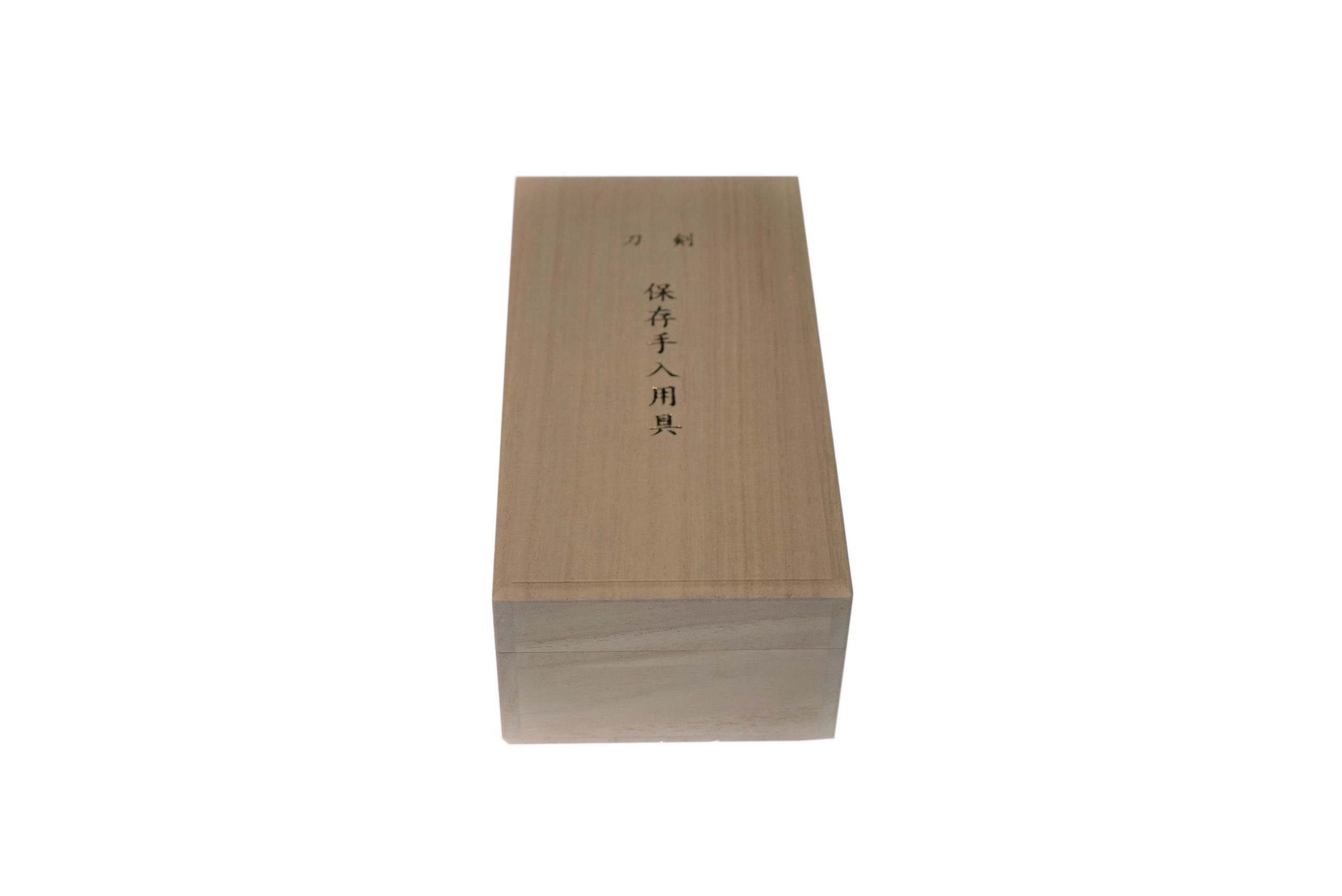
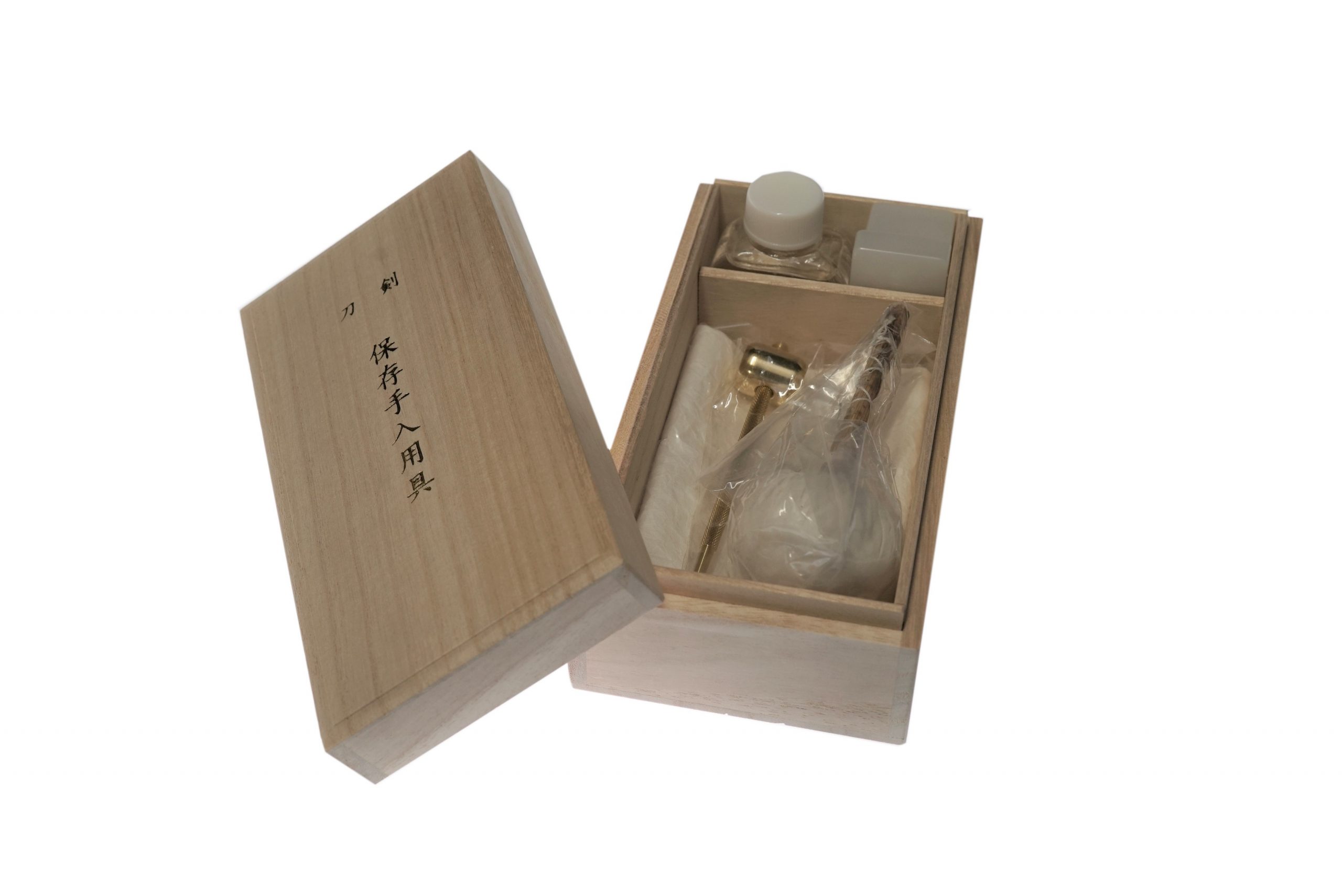
MORE ANTIQUE JAPANESE SWORD FOR SALE
SWORDS WITHOUT CERTIFICATES FOR SALE
LEARN JAPANESE SWORD TERMINOLOGY
Thank you for reading all the information on the page. If you have any difficulty choosing the right Japanese sword for you, we will be more than happy to help you find the one that speaks to you the most. Please feel free to contact us.
